
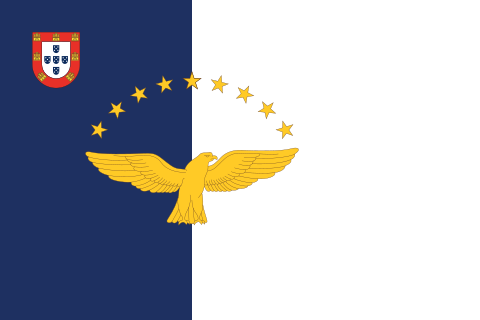
When I mentioned to a friend that I was planning on going to the Azores, I was asked ‘Where’s that?’ Well, the Azores Islands, or let us say the island of São Miguel, which is the biggest, are about 950 miles as the crow flies west from mainland Portugal. The Azores make up one of the autonomous regions of Portugal and there are nine islands altogether in three groups spread out over a fair distance. The flight from Ponta Delgada, capital of São Miguel island, for example, to Faial island takes 50 minutes on one of those two prop airplanes. So not exactly next door. Faial is the island where trans-Atlantic yachtsmen traditionally stop and my husband’s idea, years ago, had been to sail into the port of Horta on our way back from the Caribbean, but we never did return to UK – at least not until much later, and not under sail. So I have been left wondering for some years what we missed.

The islands are volcanic, situated at the junction of three tectonic plates: Eurasian, North American and African. One would expect the scenery to be similar to Iceland, also volcanic (see Iceland: The Golden Circle and Blue Lagoon). It is, and there are steaming hot pools, calderas and crater lakes. But is much greener, there are more trees and the islands are full of flowers, especially blue hydrangeas, growing along the roadsides. It is, of course, much warmer being of latitude 38-40 degrees north, as opposed to Iceland’s 64-66 degrees north. Temperatures hit about 25 or 26 degrees in the summer. Which is when my American friend, Ellen, had booked to visit the island of São Miguel and I naturally wondered whether she might be in need of company. Positive response. She was in fact going with a couple, so I would save her hanging about in a threesome, which can be irksome to a twosome on a romantic holiday.
São Miguel
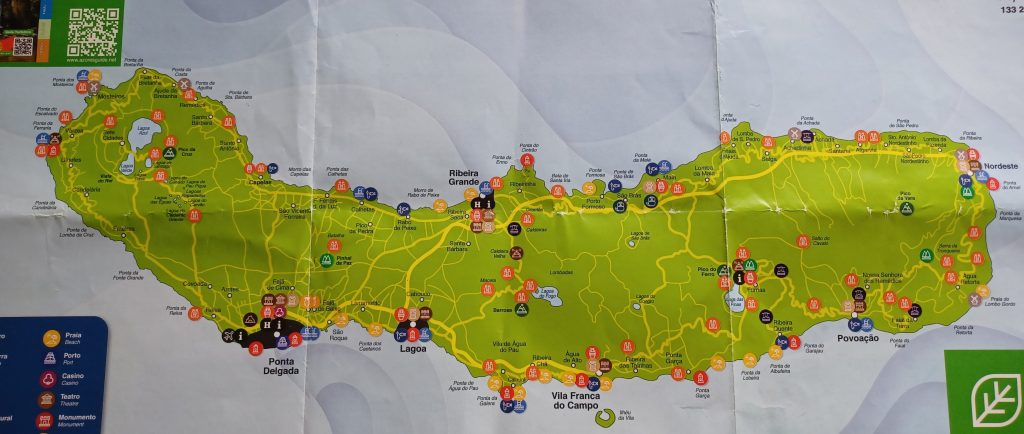
Lagoa
An Airbnb has been booked at a place called Lagoa, a short distance east of the capital, Ponta Delgada. We arrive after nightfall and the reception is closed. Not to worry. There are instructions as to how to reach our apartment. Some while later, after searching ‘around the back’ for an elusive staircase, we venture down a narrow corridor to the door, where one of those key boxes is screwed to the wall. Tap in numbers. Open sesame. Key appears. Put in keyhole. Twist and turn and push and pull key in hole. Door remains firmly shut. Think about phoning the owners. One last go before this final resort. Very stiff door. Give it a good shove and go hurtling in through the doorway into a large emptyish mustyish room with one table and a few chairs in the middle of it.
Open all the windows. No bottled water provided. Kettle though. Have some mini milk cartons with me along with a stash of tea bags. Sink into chair with tea. Ellen seeks out bottled water from some friendly neighbours and all is right with the world. We are told later that the drinking water in the Azores is of outstanding quality, so no need to purchase bottled water when there is plenty of good water from the tap.
On closer inspection, the apartment turns out to be pretty good with all the necessary comforts. A path through a lovely garden meanders to a lower road. And an oval shaped swimming pool shimmers serenely surrounded by sunbeds and foliage. The town of Lagoa turns out to be one of those rather fabulous places, once I have found the supermarket that is. A tiny super shop, packed to the gunwales with foodstuffs. Pick up some necessaries then head off to explore.
Wonderful church here, the Church of Nossa Senhora do Rosario. All churches in the Azores, we soon find out, are built of basalt with white painted walls. Very attractive looking. This one has two bells in the belfry and green painted doors. Situated one side of the very large central square.
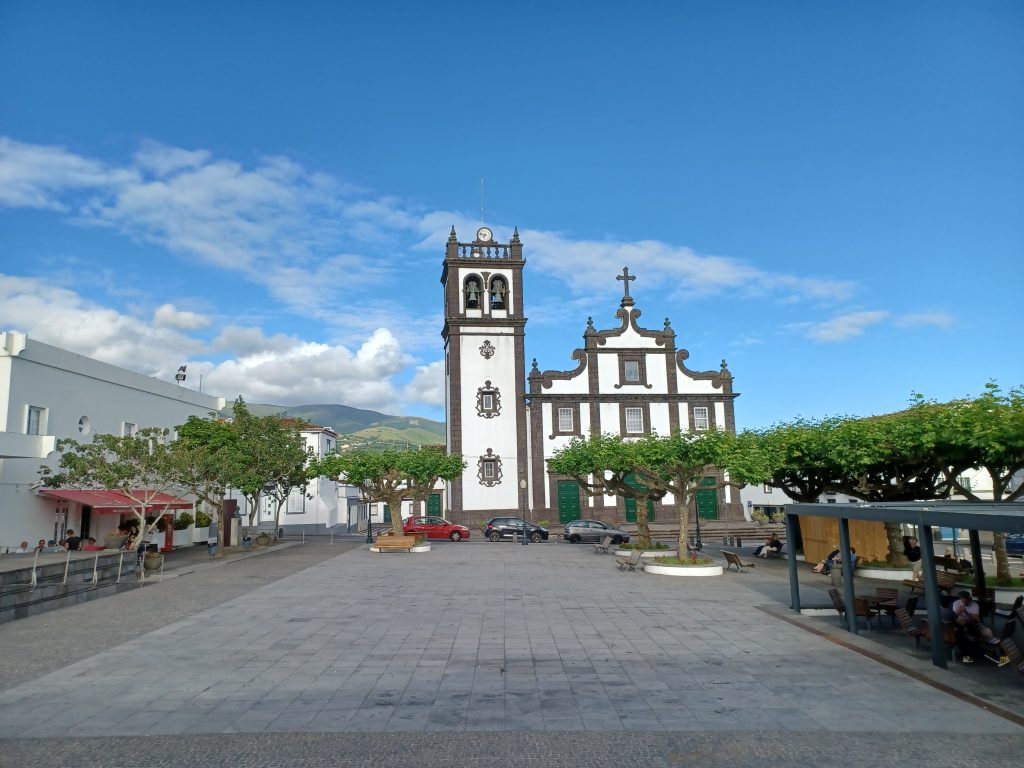
Ellen’s friends, an American couple of more senior years in the first flush of romance, have hired an apartment elsewhere in Lagoa. They have hired a car too, so come and fetch us to visit their apartment. Stunning view from their balcony of a crescent shaped bay with another of the Azores’ typical churches perched on the cliff edge. Thence, we head off to a restaurant by the water. Boats are standing on the hard nearby in the little harbour. We consume chunks of meat on skewers with plenty of Portuguese red wine to wash it all down with. In festive mood.
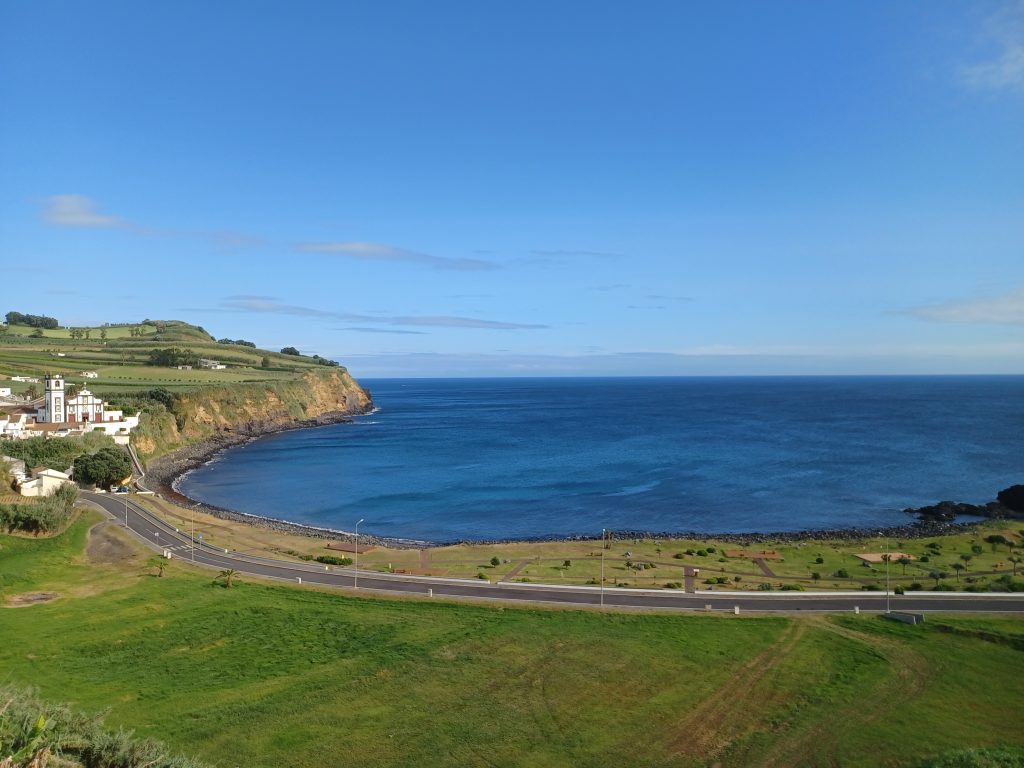
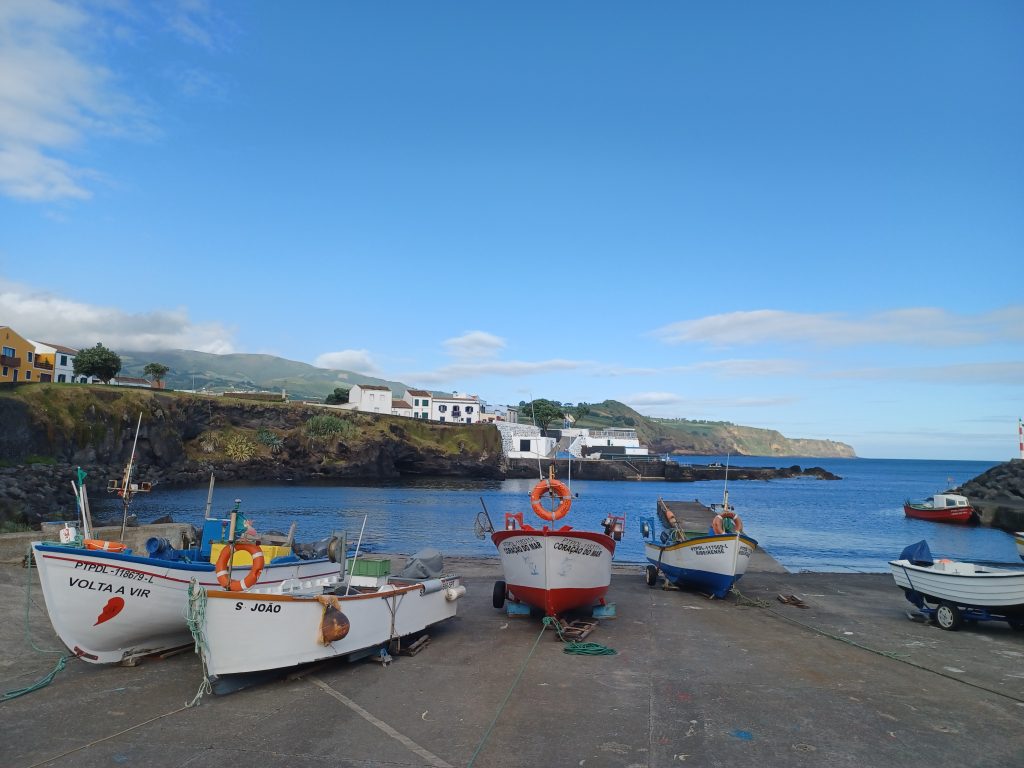
Ponta Delgada
Festival of the Holy Spirit
Today we visit some places of interest in the capital, Ponta Delgada. Go by car. Find a parking spot, not without excitement, vehicles competing for that sole tempting vacant space. Bit of a scrum. We happen to be here on a saint’s day, that of Espiritu Santo (Holy Spirit), which is held in July and celebrated throughout the archipelago. Parked up, we follow the joyful footsteps of those in front and arrive in a large square, the Campo de São Francisco, where we queue with the locals for lunch of Espiritu Santo soup. This splendid dish consists of huge boiled cabbage leaves and boiled meat in broth with bread. Followed by rice pudding sprinkled with cinnamon. All comers are welcome to indulge. For free. This tradition dates back to the time of settlement of the islands by the Portuguese in the 16th century, when food was distributed to the needy, I understand. We sit down on benches either side of long tables and chat to the locals. Rather chaotic and jolly atmosphere.
Santo Cristo do Milagres
There are many festivals held in the Azores, mostly of the religious variety. 90% of the population is Catholic, I gather. The most important festival celebrates Santo Cristo do Milagres, meaning Holy Christ of the Miracles, annually on Whitsunday. The church dedicated to Santo Christo is on one side of the square. Not an especially beautiful façade but the interior is dazzling. It glitters with gold in the sanctuary and azulejos (blue and white tiles) on the walls. The tiles show scenes from the life of Mother Teresa da Anunciada (Teresa of the Annunciation), a nun, not the Mother Teresa who went to India, but another one, born in 1658 in the Azores, who paraded a wooden bust of Jesus in procession around Ponta Delgada. In 1713 an earthquake stopped during the procession, hence ‘Holy Christ of Miracles’. Fascinating story. Emerge spiritually uplifted.
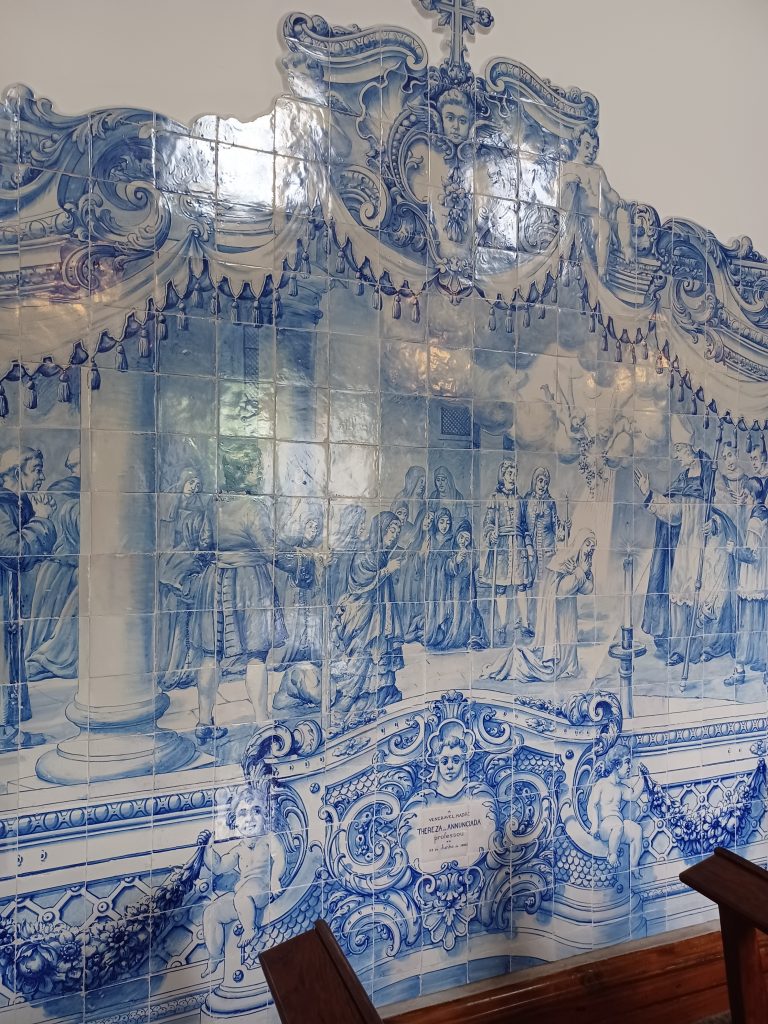
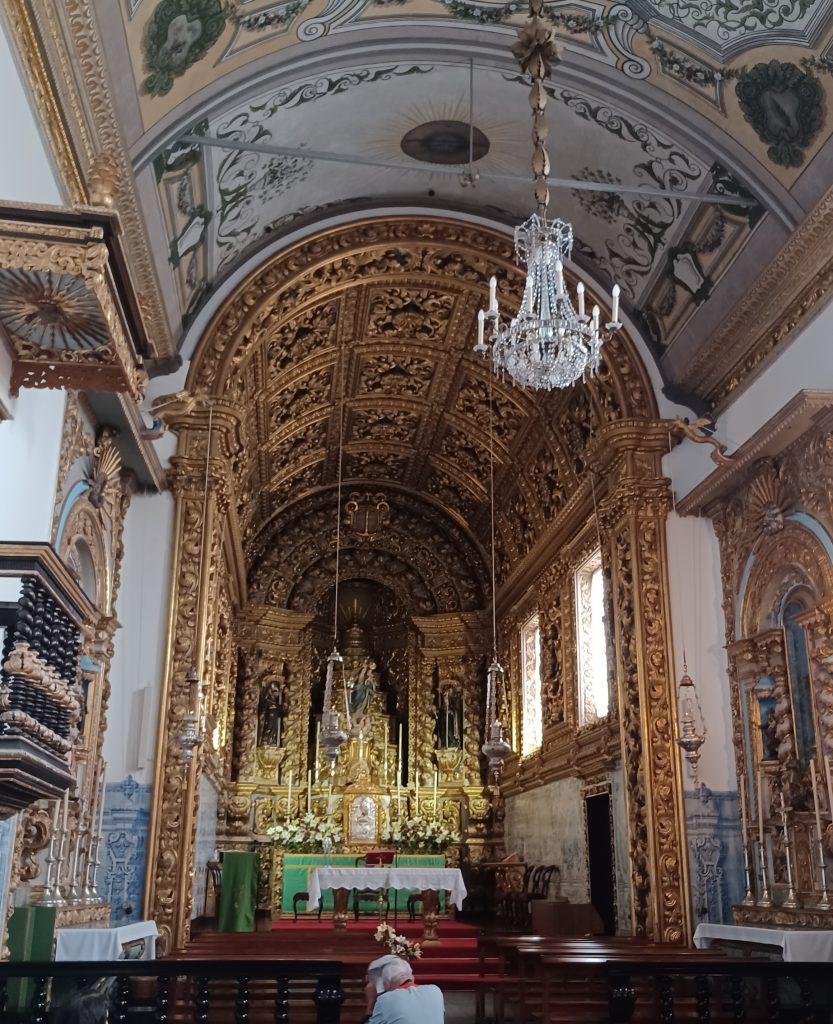
Fort of São Bras
Sated with soup and magnificence, we now proceed to the 16th century Fort of São Bras. Now this has an interesting history. Originally built to protect the city against pirates, it has been used since to defend the islands on several occasions, including during the two world wars. The fort, built of thick black basalt with four bastions and quadrangular plan, was much changed and reinforced during the wars and machine gun positions were installed. American ships crossing to Europe were able to refuel here ‒ at this mid-Atlantic position between the USA and Europe. The fort now houses the Azores Military Museum and a Portuguese naval base.
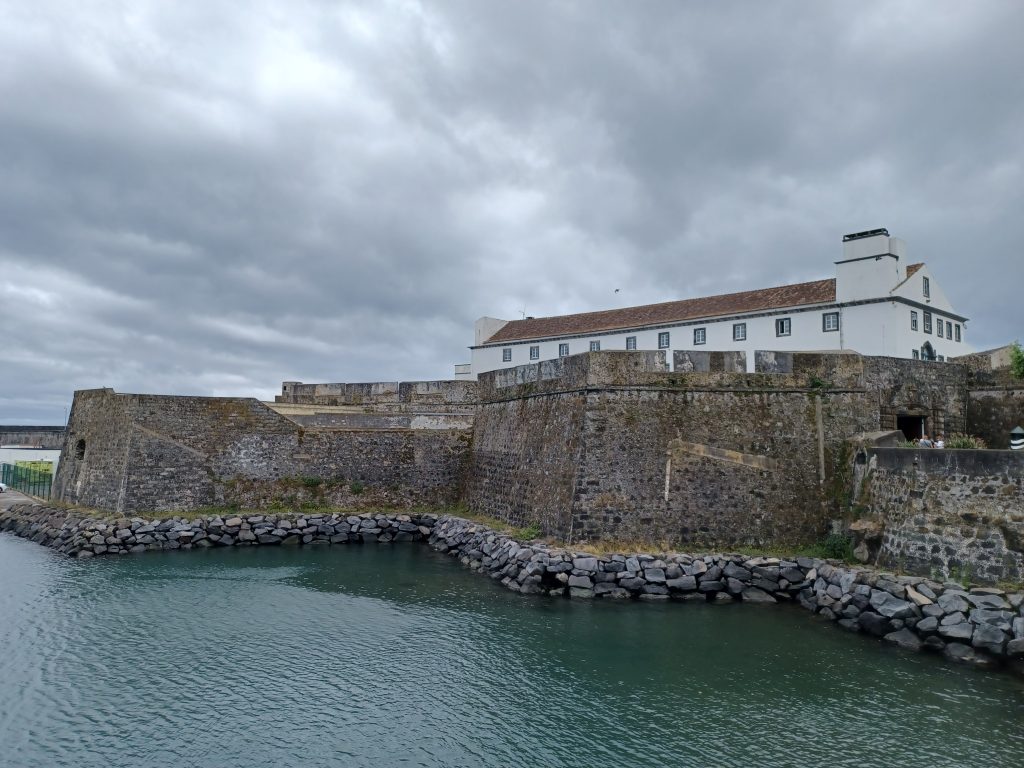
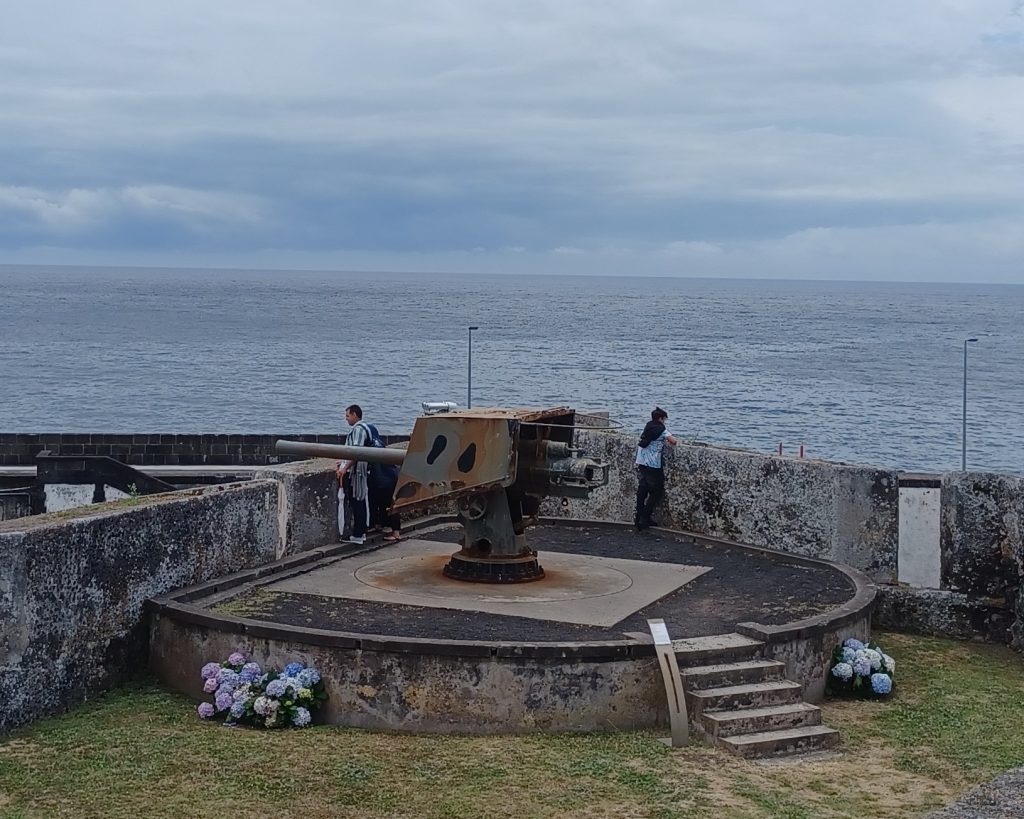
We ramble round the walls eyeing the gun emplacements strategically situated pointing out to sea. Then spend time under the fort’s stone vaults in the museum reading about its history and surveying the collection of military artefacts.
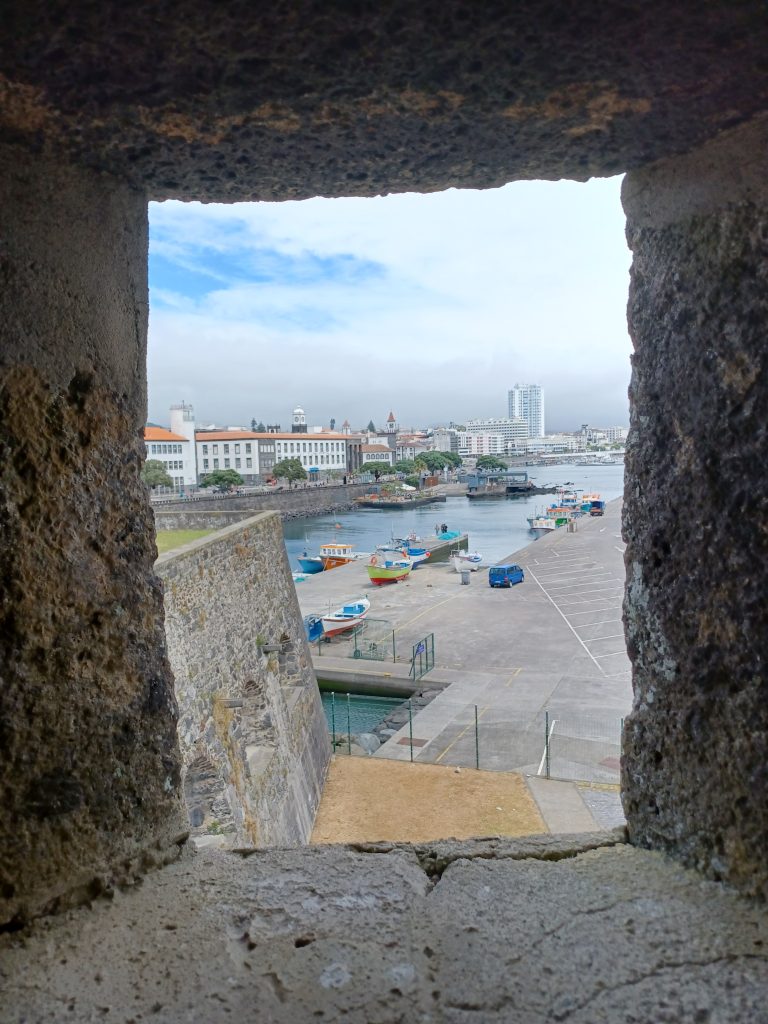
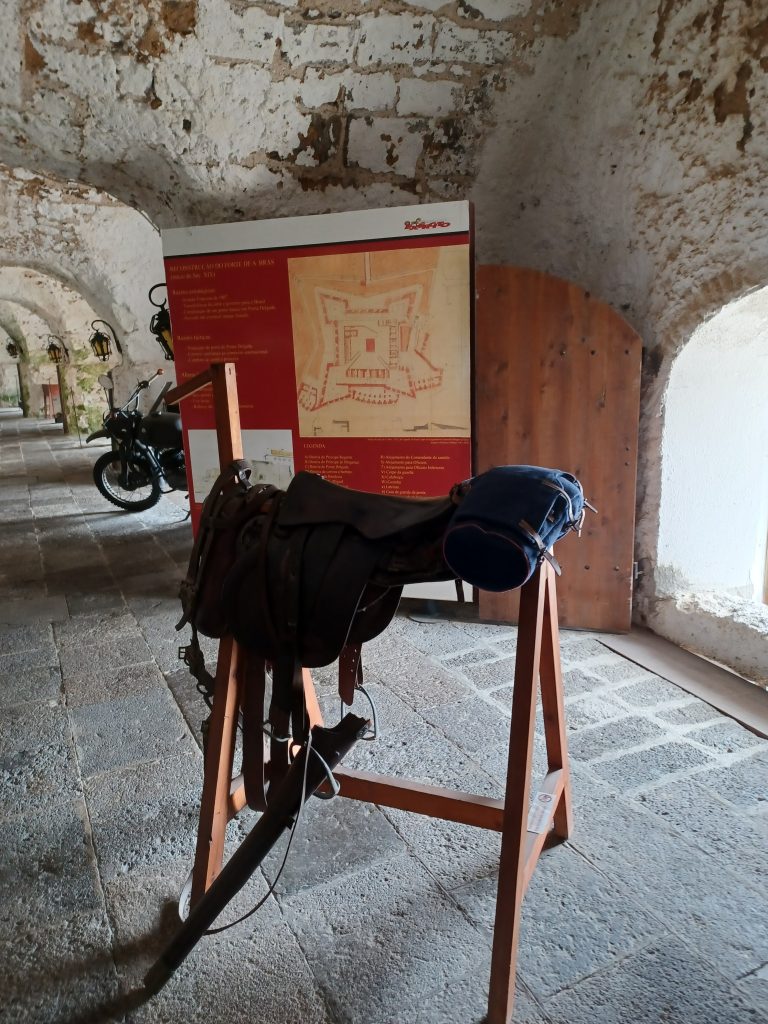
Monument to the Emigrants
We leave the fort and continue exploring the town. Come across the Monument to the Emigrants by Álvaro Raposo de França. Made of bronze, it depicts a family of three and is dedicated to all those from the islands who emigrated for pastures greener in the late 19th/early 20th centuries. Male half of couple is especially interested in this monument as his ancestors were amongst those who moved from here to Fall River in the USA. In fact Fall River is twinned with Ponta Delgada.
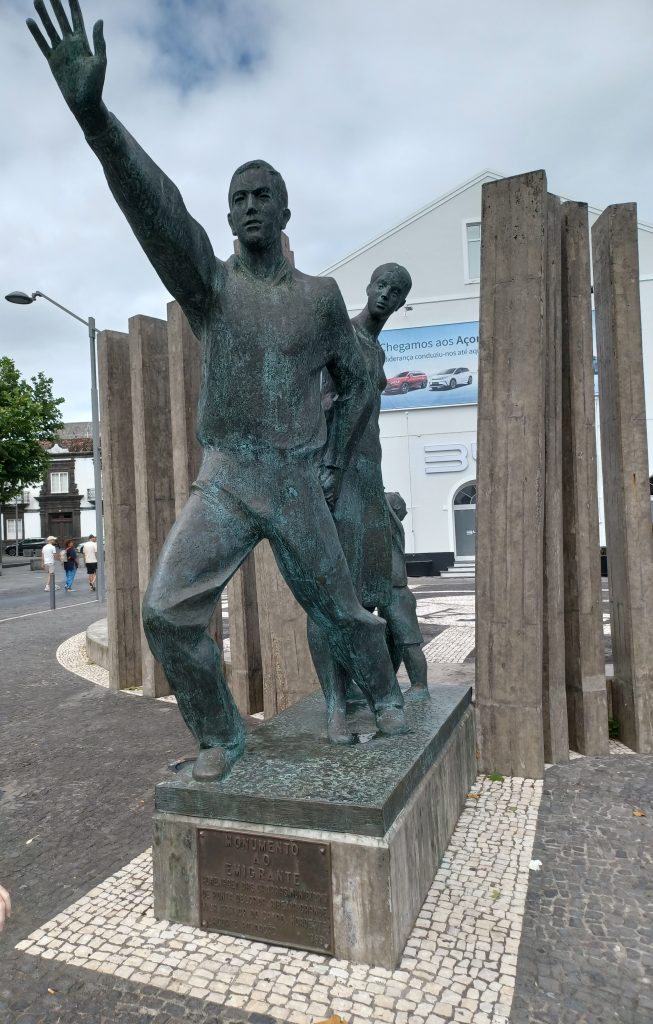
Parade, Festival of Espiritu Santo, Ponta Delgada
There is a parade through the town this afternoon in which an image of Espiritu Santo will be on view. We hasten to the main road and take up positions on the harbour wall waiting for the revellers to arrive. Takes some while, so purchase ice-creams in the interim. Eventually a couple of accordionists and drummers pass along behind a red tractor conducting the banner of Espiritu Santo. We shift off the wall closer to the action to observe the locals dressed in costumes promenading behind the musicians and flower covered floats following them. People clap and wave and tap their feet and all that sort of thing. Exceedingly lively and colourful.
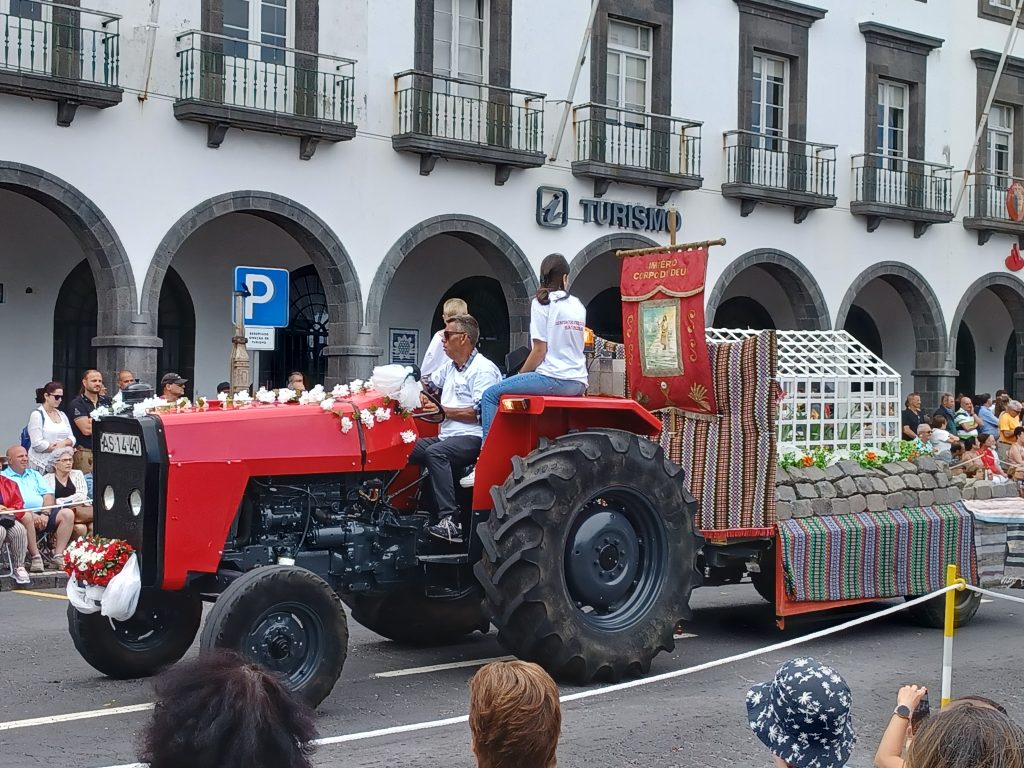
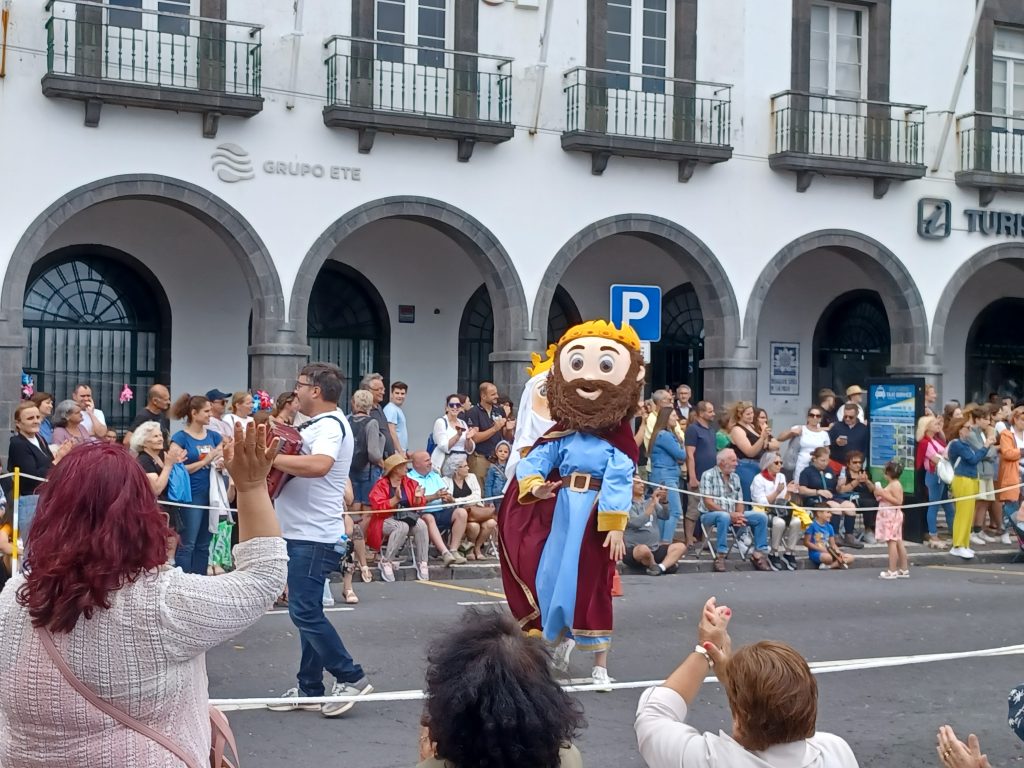
Lagoa das Sete Cidades
Today the intention is to drive around the coast of São Miguel. The scenery is supremely green and luscious. Not for nothing is it nicknamed ‘The Green Island’. First we go to the far west of the island to Lagoa das Sete Cidades along roads lined with blue hydrangeas and yellow ginger flowers. The ends of the stems of these latter taste sweet when chewing. Many agapanthas with their long stems and large blue ball shaped flowers stick up like lollipops in the intervening spaces.
From the road high in the hills, we look down upon a twin lake, situated in a dormant volcanic crater. One lake is blue and the other green. A bridge divides them. Legend has it that a princess wanted to marry a shepherd boy but was forbidden by her father, the King. The tears of the two lovers formed the two lakes: green of the princess’ eyes and blue of the shepherd’s. Actually the colours are due to the way the sun reflects the light differently but that is not very romantic. Anyway, the lakes are an important source of fresh water.
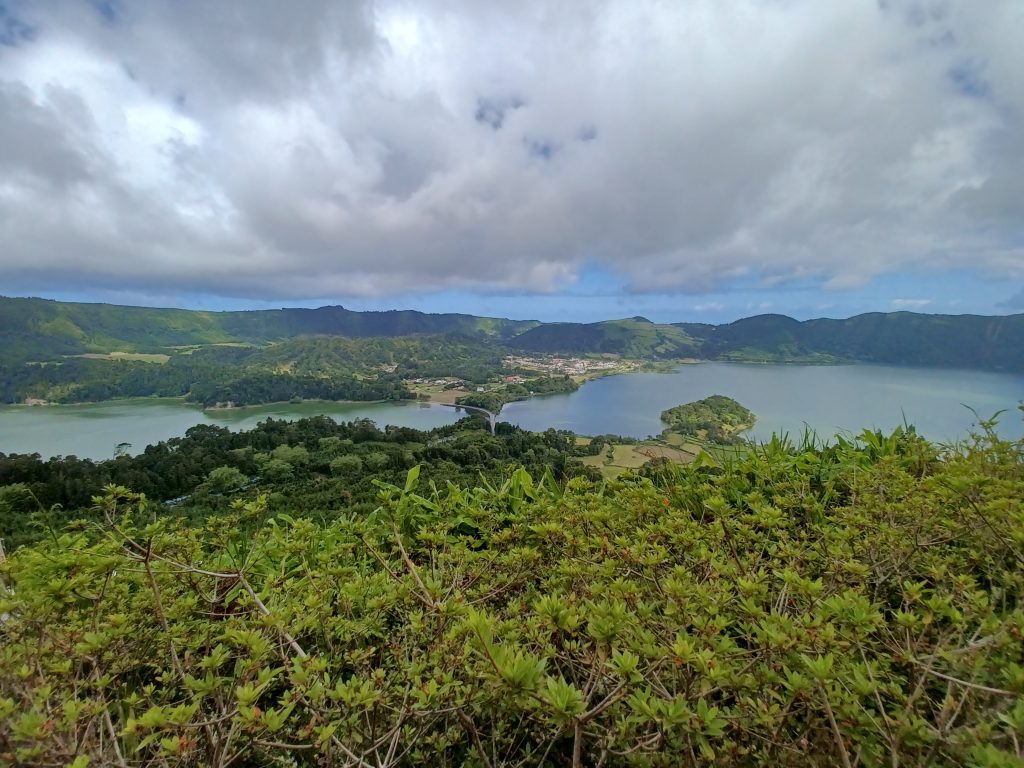
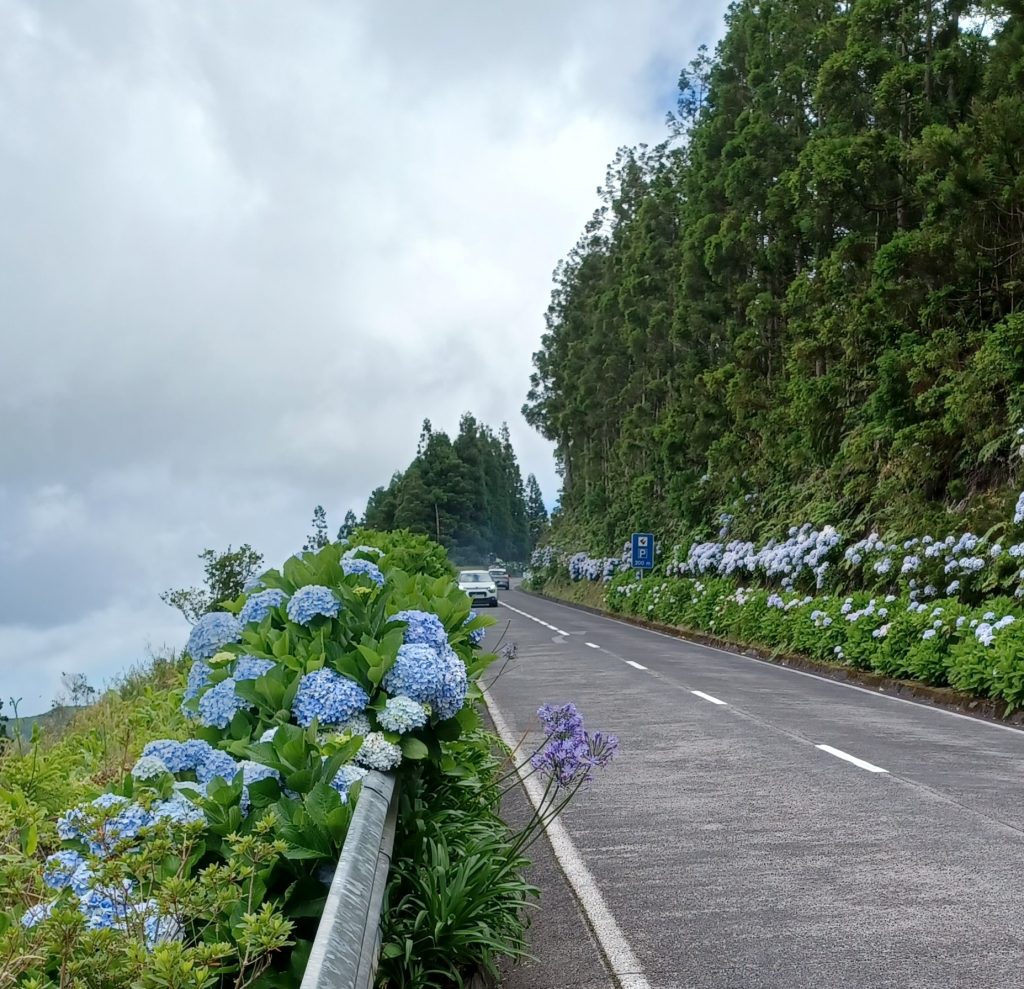
We stop on the bridge between the two lakes and stroll up and down a while before proceeding to the town, where we partake of luncheon before viewing the 19th century parish church of São Nicolau. Picturesque Neo-Gothic church situated at the end of a pathway lined with plane trees. Mown grass and flowers around it. Tranquil spot.
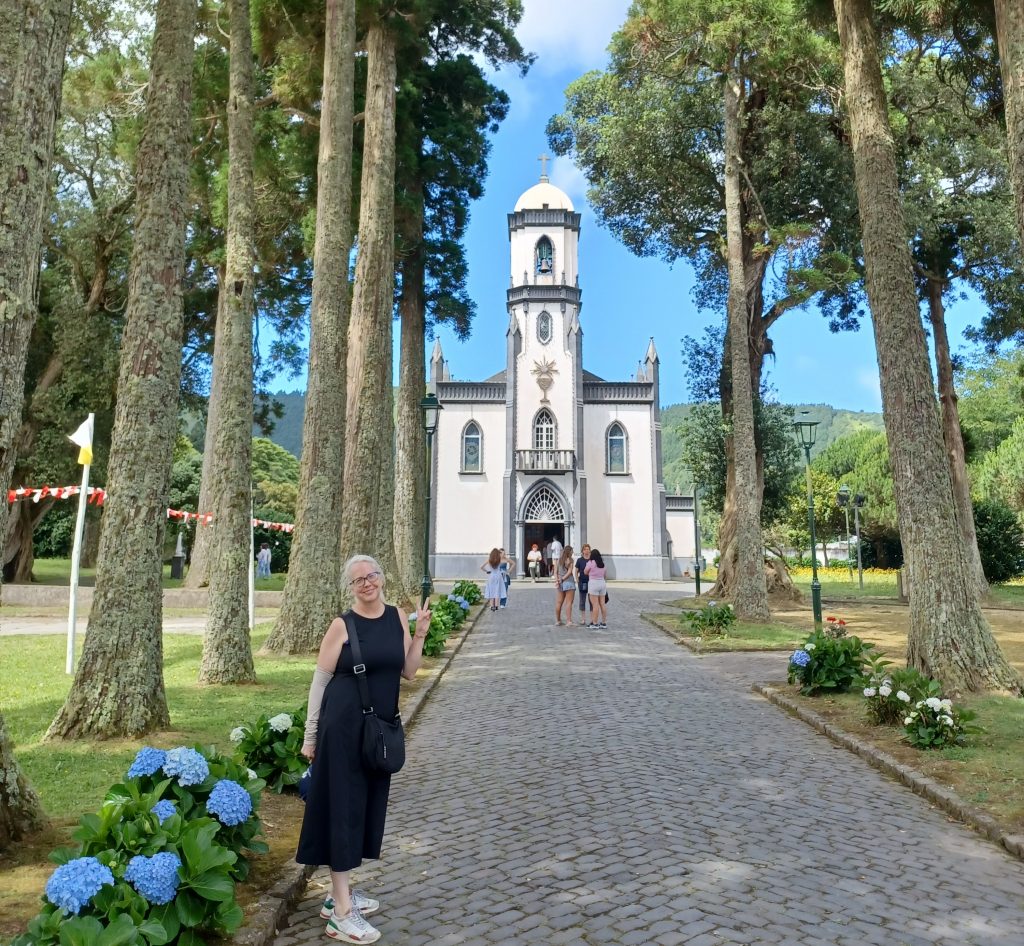
Ribeira Grande
Thence to the lovely Ribeira Grande on the north coast. A festival is happening here today. Wonder what this one is about. We head along the promenade alongside which the Atlantic surf runs up the beach. Reach some swimming pools in the rocks in which locals are bathing, then turn right into the town. There is a striking bridge here, built of basalt. It is called the Ponte dos Oito Arcos (Bridge of Eight Arches) and spans a small creek, named after the town, and some attractive gardens. The bridge, featured on the coat of arms of the city, connects the west with the east parts of the town.
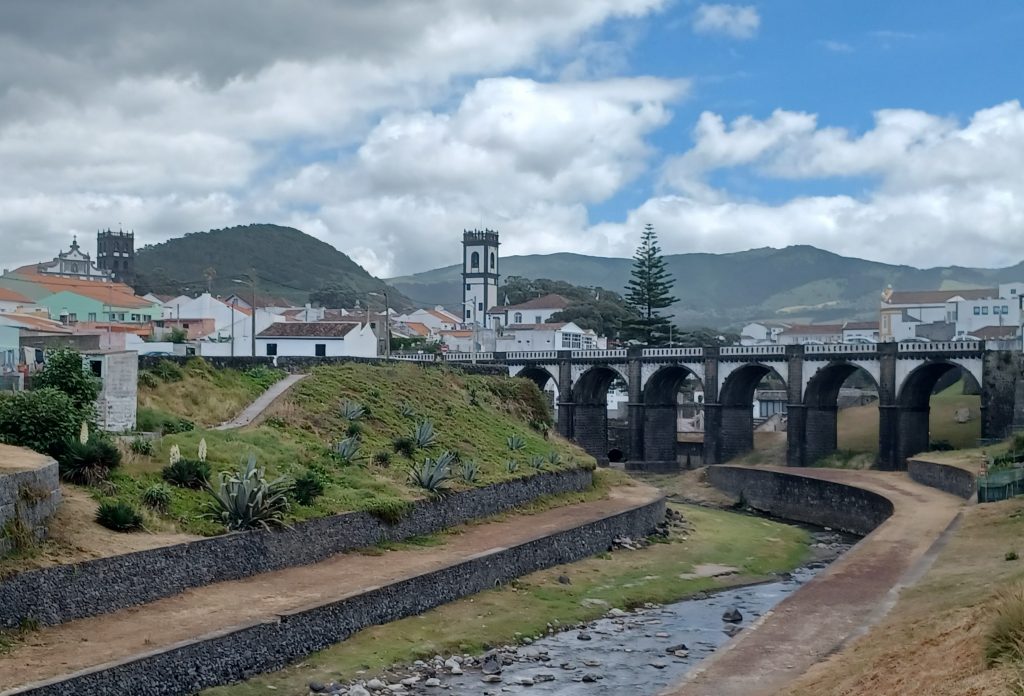
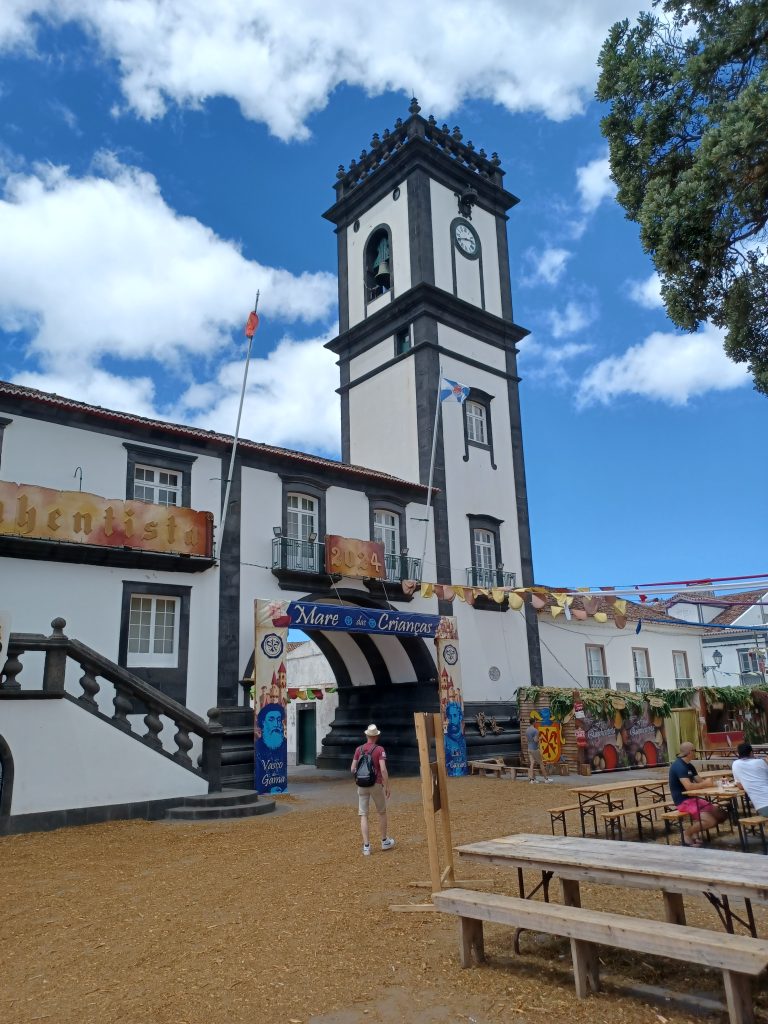
In the central area we find a booth from which we order bread and sausages and ice-cream and drinks, not necessarily in that order, and take seats at a wooden table. Find out that the town is celebrating the 500th anniversaries of two of Portugal’s famous sons: Luís de Camões and Vasco da Gama. Bit of a lull in the activities at the moment. The main events take place this evening. No doubt the locals will be out in force. I believe that there will be traditional music and performances with involvement by the younger members of the community. Lot of decorations and flags about the place.
On one side of the square is the town hall, adorned right now with pictures of these two Portuguese men either side of the large archway: Vasco de Gama was a great explorer and ship’s navigator who died in Kochi, India (see India part 3) in 1524, 500 years ago, and Luís de Camões is considered Portugal’s greatest poet, born 500 years ago. After admiring the decor and polishing off the sausages, we saunter slowly back through the town, noting two handsome churches, that of the 16th century Nossa Senhora da Estrela (Our Lady of the Star) and that of Santos Reis Magos (Three Wise Men) as we go.
Find the car and wend our way on the little roads – much lovelier than the main highway round the island – to a viewpoint over the north coast. There is a sort of track here, up which male half of couple decides to drive his hire car. It doesn’t look awfully promising and most unlikely to be the way forward. “You want adventure!” proclaims he. Err yes, but. Astounded glances from hikers as we navigate our way along. The rutted trackway gets narrower and narrower with foliage and tree roots and bamboo canes providing plenty of obstacles. Three females are harassing him to turn back. But there is no restraining him. Anyway, there is no turning space.
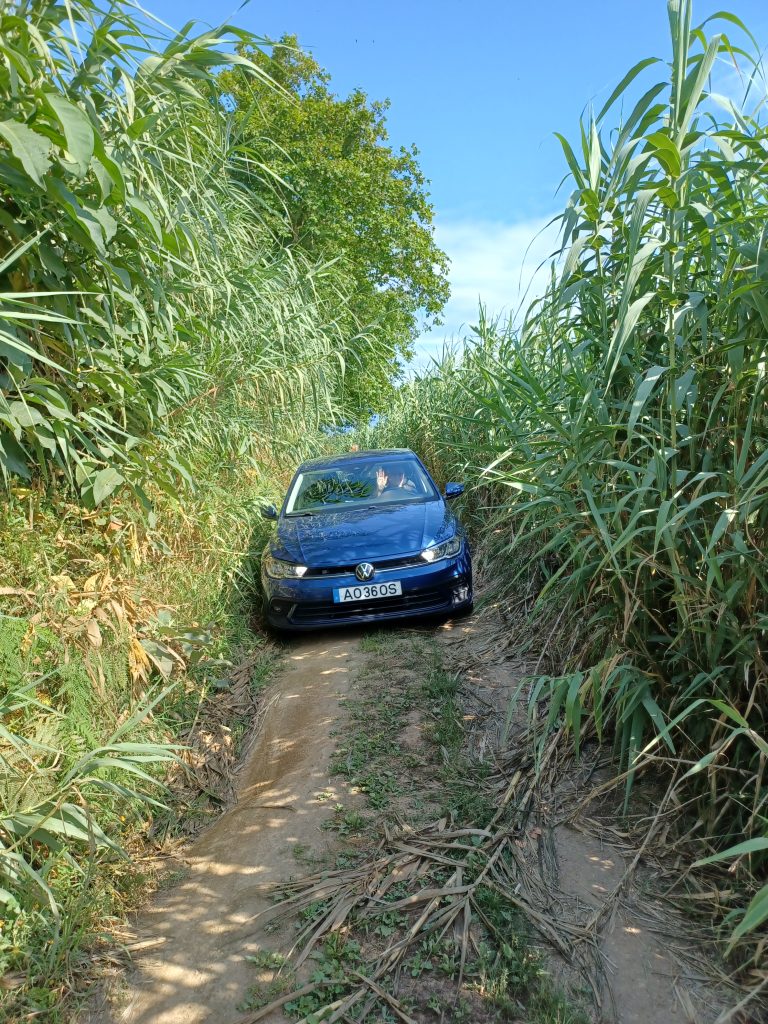
Car comes to a halt in some deep furrow or other. We alight. Self and female half of couple direct the driver backwards along the track. Some walkers are cross. Finger wagging. We exit the trail, driver rather humbled, and regroup.
Agua Retorta
Our driver has Portuguese heritage, as before mentioned, and is desirous of seeing the place whence his ancestors came. We are all for it too. On the south east coast of São Miguel is a village called Agua Retorta. Here once lived many Azoreans, who migrated to Fall River in the USA in the last century. Their descendants still live in Fall River today. In fact, a large signpost points in that direction. Only 3,900 kilometres from this spot. Gorgeous view from here. A sign on tiles states: ‘Come e belo, éste lugar’, What a beautiful place this is. Agreed. The 1960 census records the population of Agua Retorta as being over 1200, while today, despite its beauty, it is about 500.
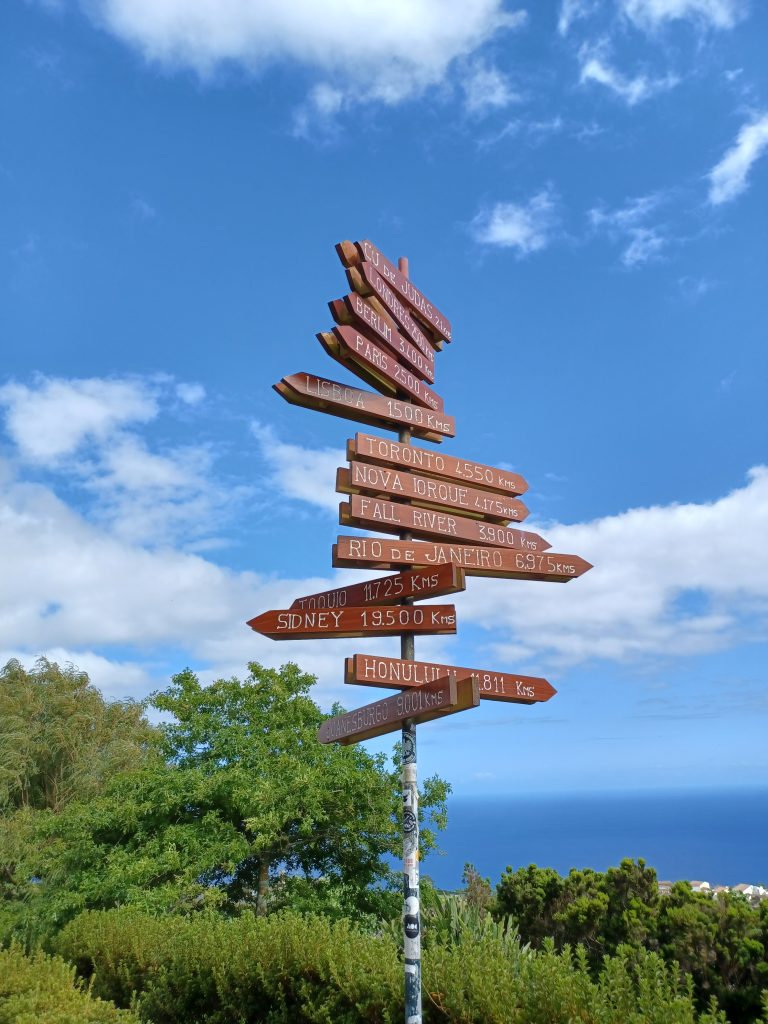
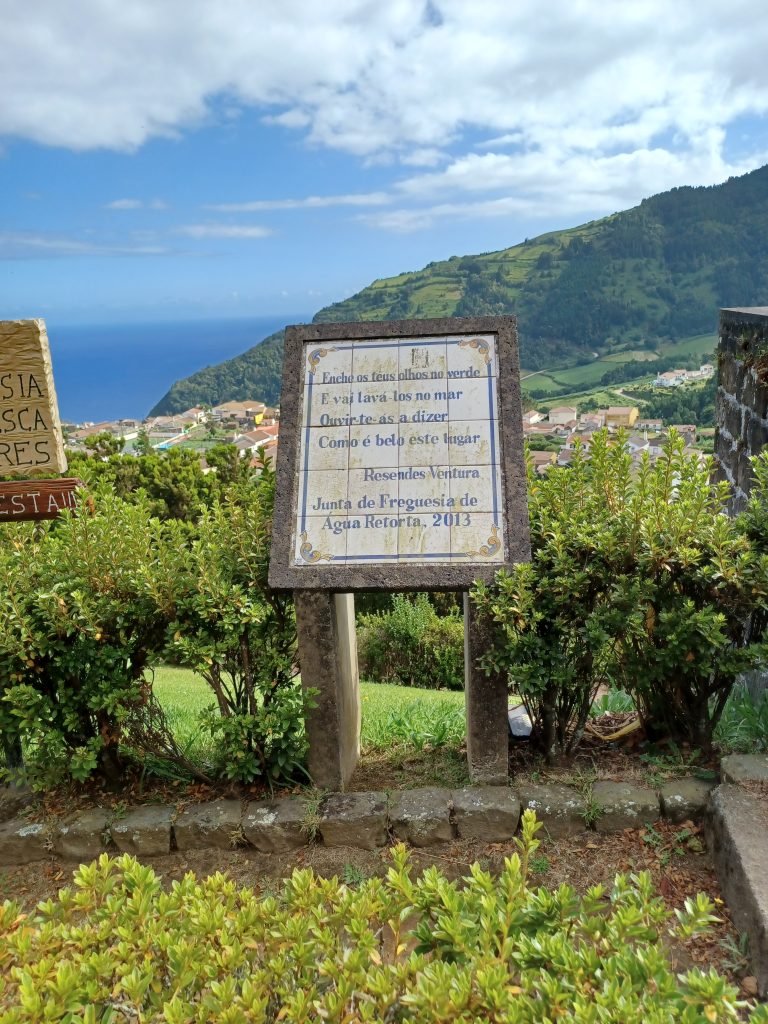
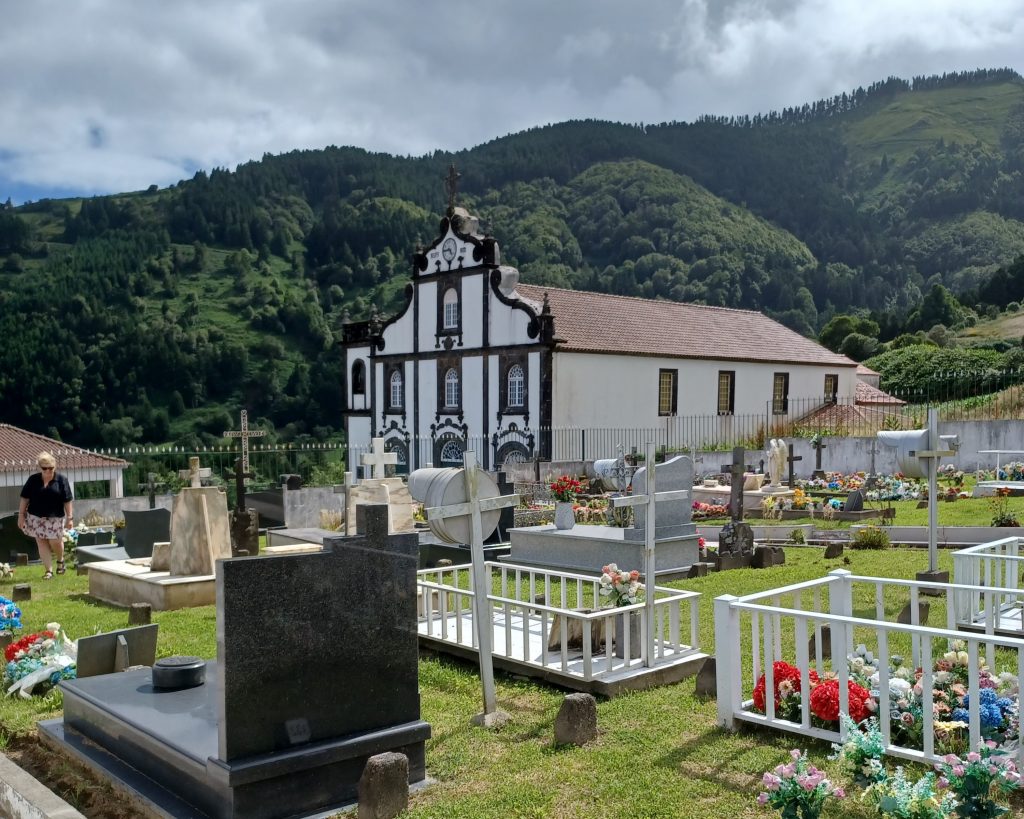
Another splendid church dominates the village, the Church of Nossa Senhora da Penha de França, built in the latter half of the 19th century. Forested hills behind. Beside it is a graveyard, neatly tended with flowers. We shuffle between the graves and find several headstones featuring our friend’s ancestors’ names.
Thence back to Lagoa via the main highway. Seems sensible as it is latish. On the way back, I am reminded that England has reached the final of the UEFA Euro cup against Spain and we must watch the match this coming Sunday. OK. With this momentous event to look forward to, the long day wends to its weary close.
Islet of Vila Franca do Campo
Next day, we two decide to join a small group on a more spacious minibus to explore the Furnas region. The thinking being that we ought to give our friends some romantic time to themselves. The tour is arranged by our Airbnb hosts with the greatest of ease. We are picked up next day and head eastwards with a few others.
First stop is at a headland on the south coast whence boats take passengers to the tiny islet of Vila Franca do Campo. Uninhabited. The islet is basically the remains of a volcanic cone, the crater of which is full of sea water. There it is possible to take a cold swim. Could be fun if you enjoy cold swims. I don’t but the birds do and there are, apparently, a few avian species to be seen there, including various terns and petrels. For this reason, the islet and its surrounds have been designated a nature reserve. Many endemic species of flora too, such as the Azorean carrot. Would be good to venture there but not on the agenda today.
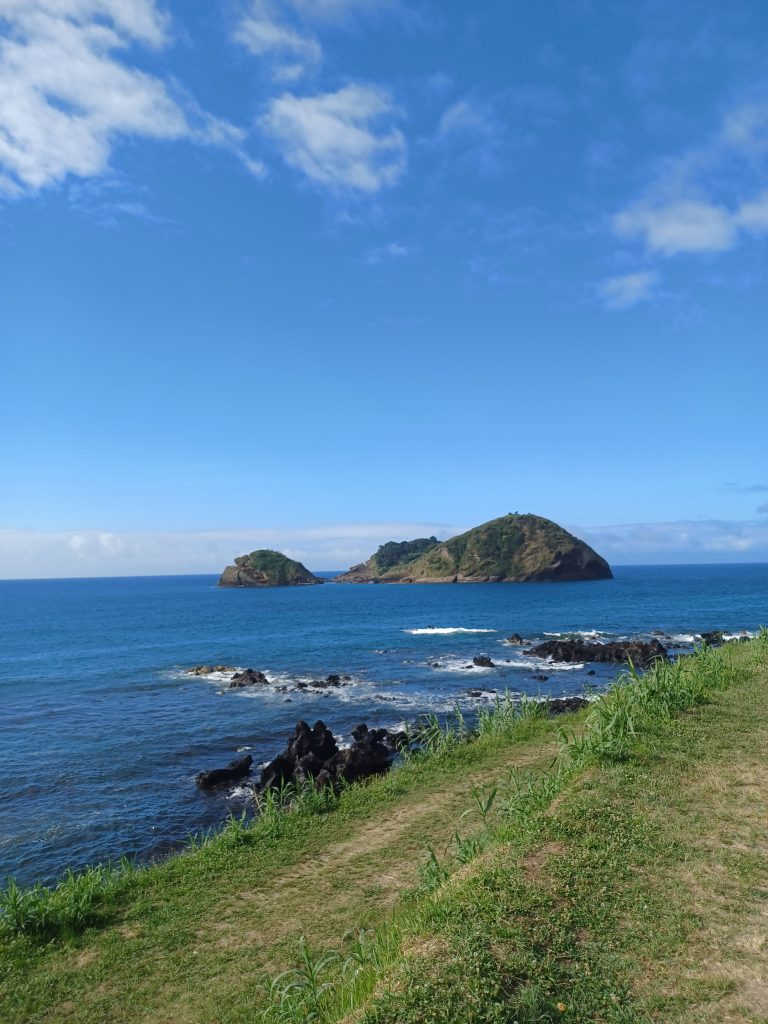
Furnas
From this point it is a short and relaxing trip to Furnas with our well-informed guide. Furnas is famed for its stunning crater lake and a geothermal area of steam and bubbling hot pots. The lakeside is surrounded with grass, adorned with green paddle boats and kayaks along with trees amongst which we wander. Have to pick up our feet a bit to step over the tree roots, which stick up above the surface to enable them to escape the heat in the ground underneath.
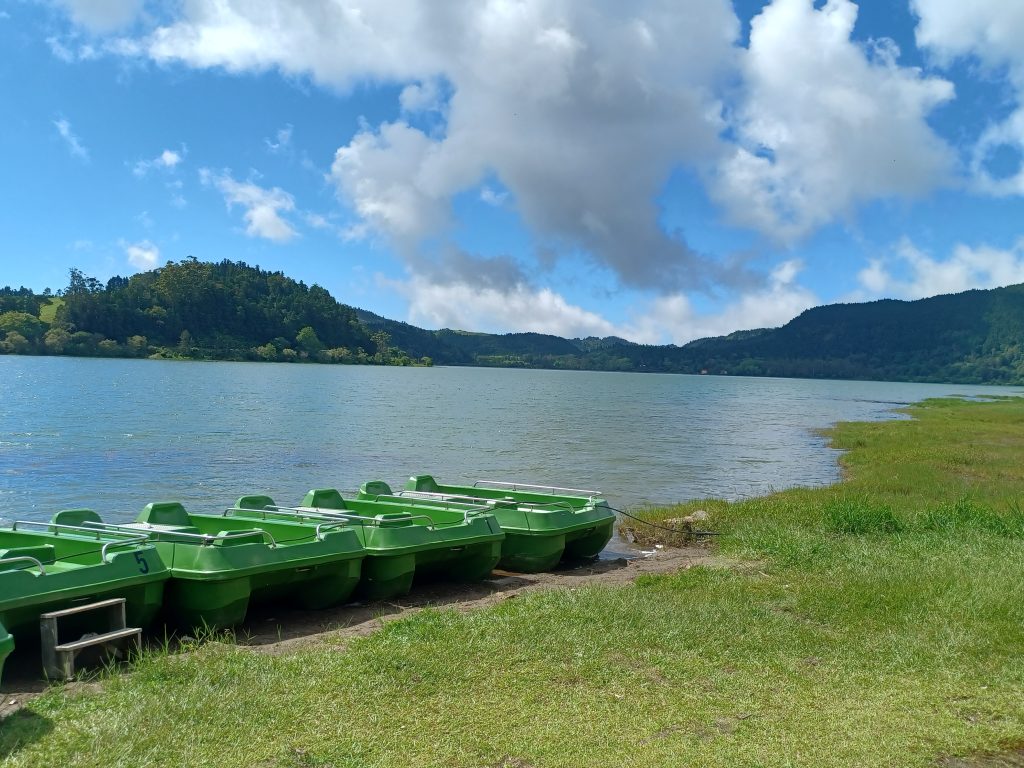
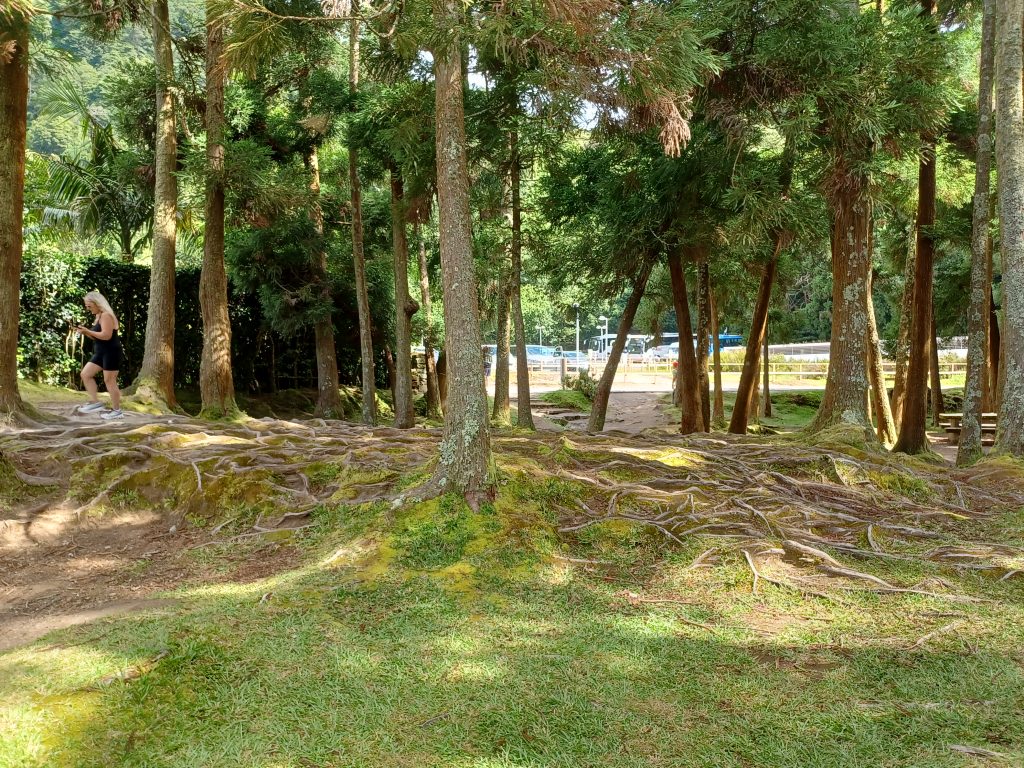
Thence we wander the walkways from which to view the geothermal area up close. Large gurgling and hissing hot pots and fumaroles. And in the hot ground have been dug deep ditches in which the local restaurateurs boil stews called ‘cozidos’ in big metal pots. There they are left to slow cook for several hours. Each pot has the name of the owner on a post on top. Our group is booked into a large restaurant to indulge in this stew, Cozido das Furnas, a mass of cabbage leaves and bland boiled meats piled up on large white plates. Lot of chatter and clatter.
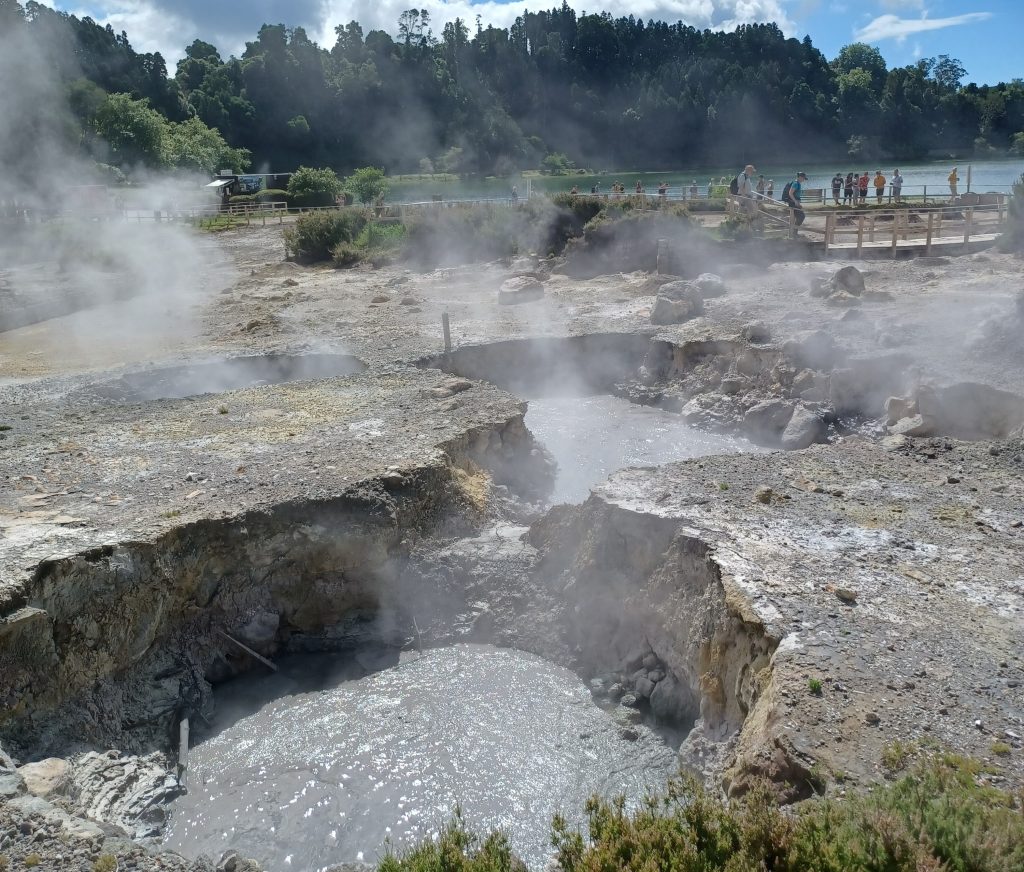
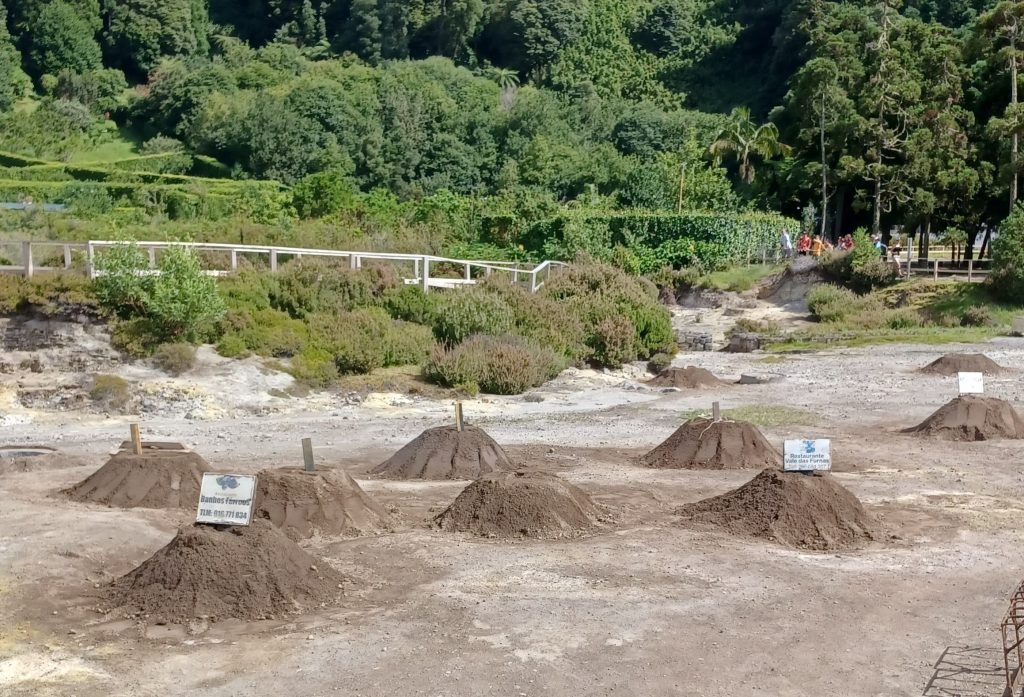
Close by the restaurant we observe corn on the cobs being boiled in the natural hot water. Produces an insipid yellowish/greenish colour. Reeks of sulphur all over the place, a bad egg smell.
The driver now takes us to the top of the mountain to the best viewpoint in the area, the Pico do Ferro, overlooking Furnas crater and the hills yonder. Short but steepish hike from the carpark up hydrangea paths to the top. We pose for pictures and enjoy the spectacular views.
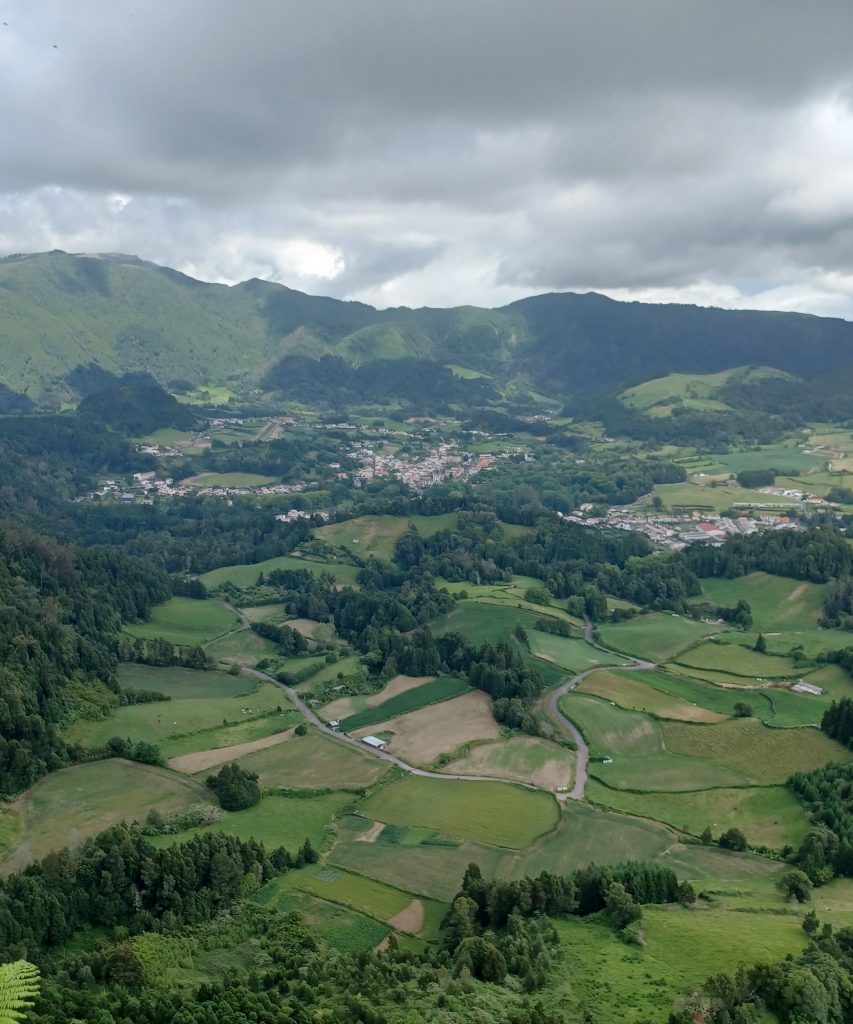
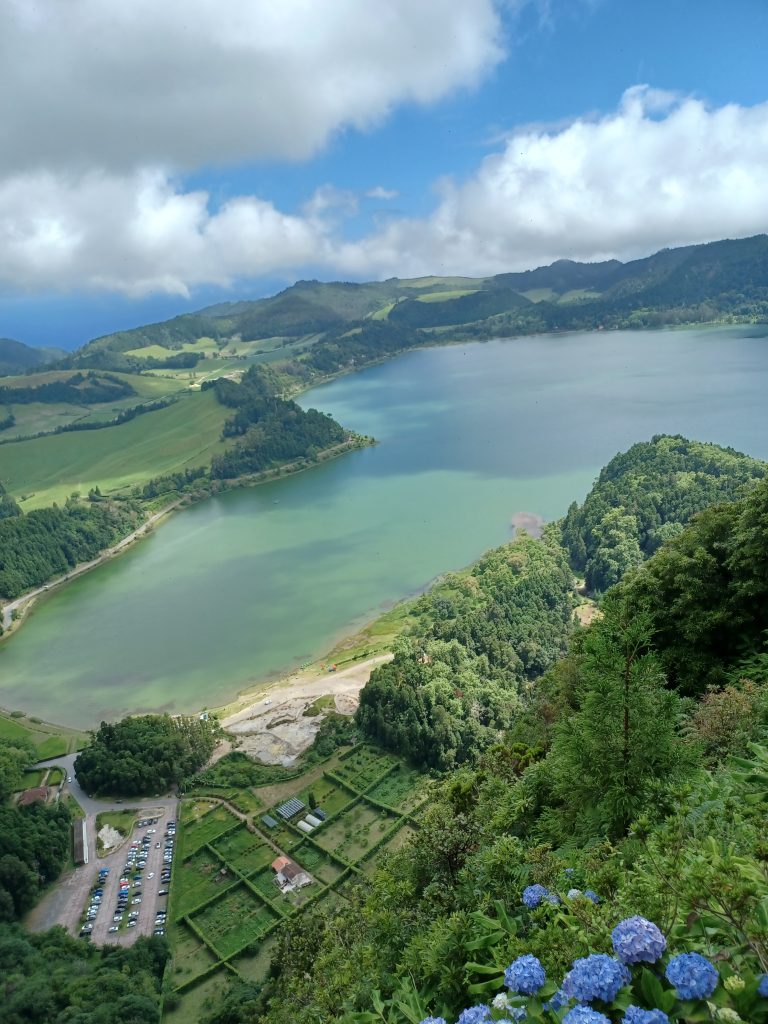
Terra Nostra Park
Destination now: Terra Nostra Park for a dip in a pool heated by geothermal heat. Large changing room where we don swim suits, before emerging outdoors to drop gingerly into this sizeable warm brownish pool. Not exactly inviting but I am assured it is full of healthy minerals and all those good things. Plenty of folks here enjoying the experience. After a while splashing about we hoik ourselves out. Grab the towels, left under a convenient bush, and retreat to the changing room for refreshing fresh water showers. Then stroll about the park’s extensive grounds admiring the lush foliage until time to return to the bus.
Porto Formoso
The mild climate of the Azores enables the growing of tea. There are two tea plantations on São Miguel and we visit the one at Porto Formoso. We are told that these are the only tea plantations in Europe. I dispute that of course, as I happen to know there is one in Cornwall. Though perhaps not plantation size – depends on your definition I suppose.
Another stunning view over the north coast here. Quite close to Ribiera Grande where we were yesterday. A bit of a pep talk is provided before a wander about the grounds. Rather a decent tiled terrace from which to observe the rows of tea bushes sloping seawards. Followed by a cup of tea, naturally. And thence back to Lagoa.
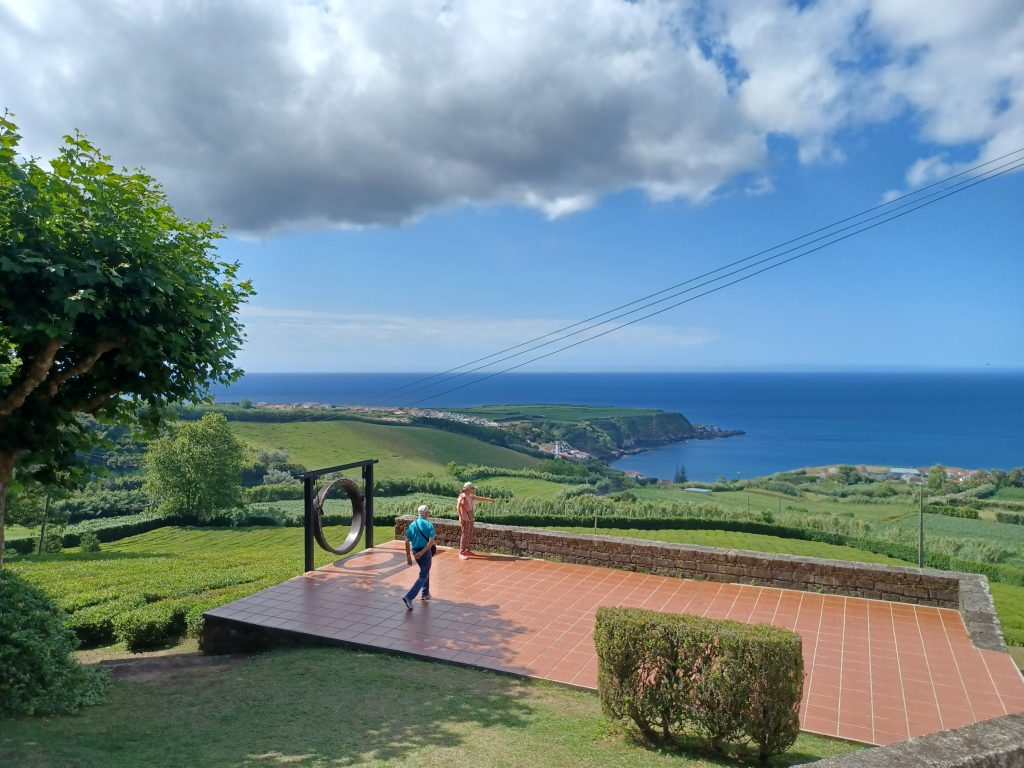
It is the evening of the football match in which England is playing Spain in the UEFA Euro Cup Final. Suitable provisions purchased we are picked up by our friends for this evening’s entertainment in their apartment. England loses, needless to say, but we have plenty of cheery fizz and foodstuffs to counter the disappointment.
Ceramica Veira
It is our last day on the island and we stay local in Lagoa. We two visit the Ceramica Veira, a pottery factory specialising in hand painted pottery and those blue and white azulejos with traditional patterns. The only pottery in the Azores apparently, founded in 1862. It is fascinating to watch the artisans at work. Reminds me of the ceramic workshop in Fez (see Morocco, part 3), though not on such a large scale.
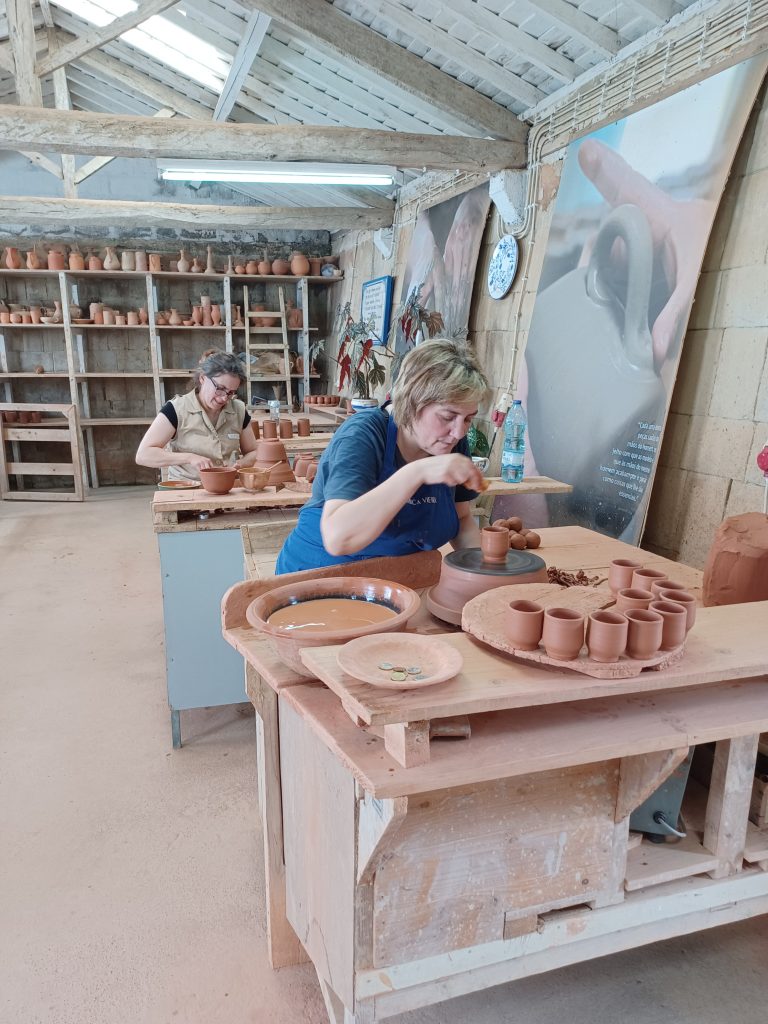
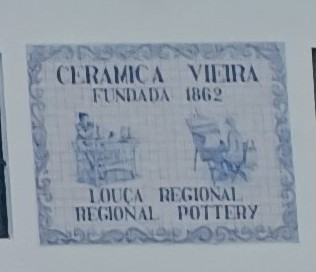
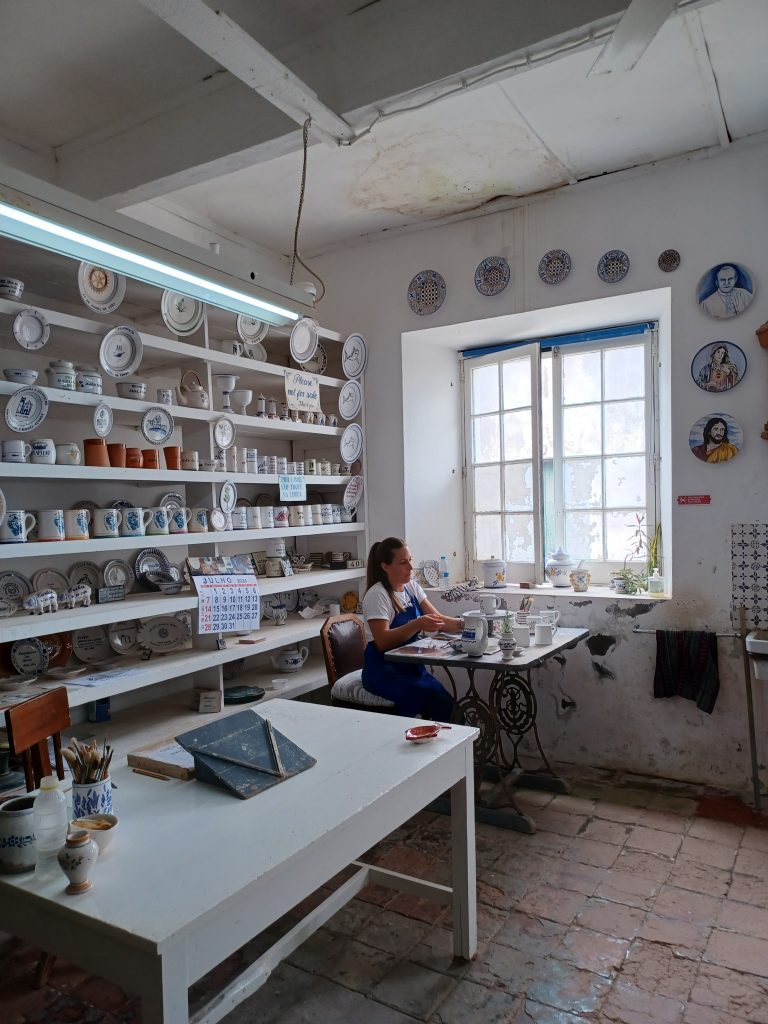
Santo Antonio Pineapple Plantation
As well as tea, pineapples are also grown on the island. Drive the short distance to visit the Santo Antonio Pineapple Plantation, founded in 1911. A short film is shown before we are led off for a guided walk. Not their usual environment, which is tropical, pineapples were first brought to the Azores as an ornamental plant, we learn. Behold the pineapples, not grown in the open air but under glass, carefully tended in the traditional manner by hand. “We can open the windows in the roof”, says the guide, “to control the moisture content”. “And the glass is whitewashed”, he continues, “so we can control the amount of light or heat”.
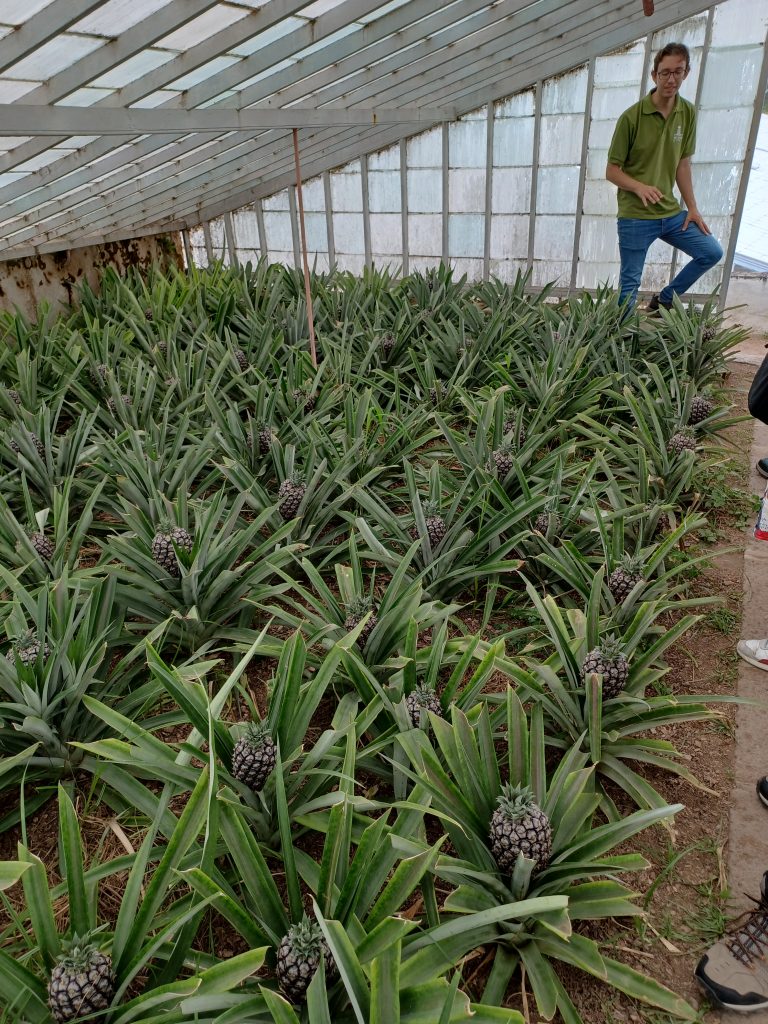
No pesticides or synthetic fertilisers used in their tendering either. We purchase some pineapple products from the little gift shop on the premises. Pineapple jam for me to take home. And, right now, pineapple ice-cream hits the spot.
An evening follows at a house owned by an acquaintance, perhaps a distant cousin, of our American/Portuguese friend. Not sure how well acquainted they are but, anyway, we are all included in the invitation. Portuguese hospitality at its best and gourmet cooking at its best. Melt in the mouth steaks and quality red wine, cheery conversation and all of that. Meander home late. Starry night. A fitting finale.
Faial
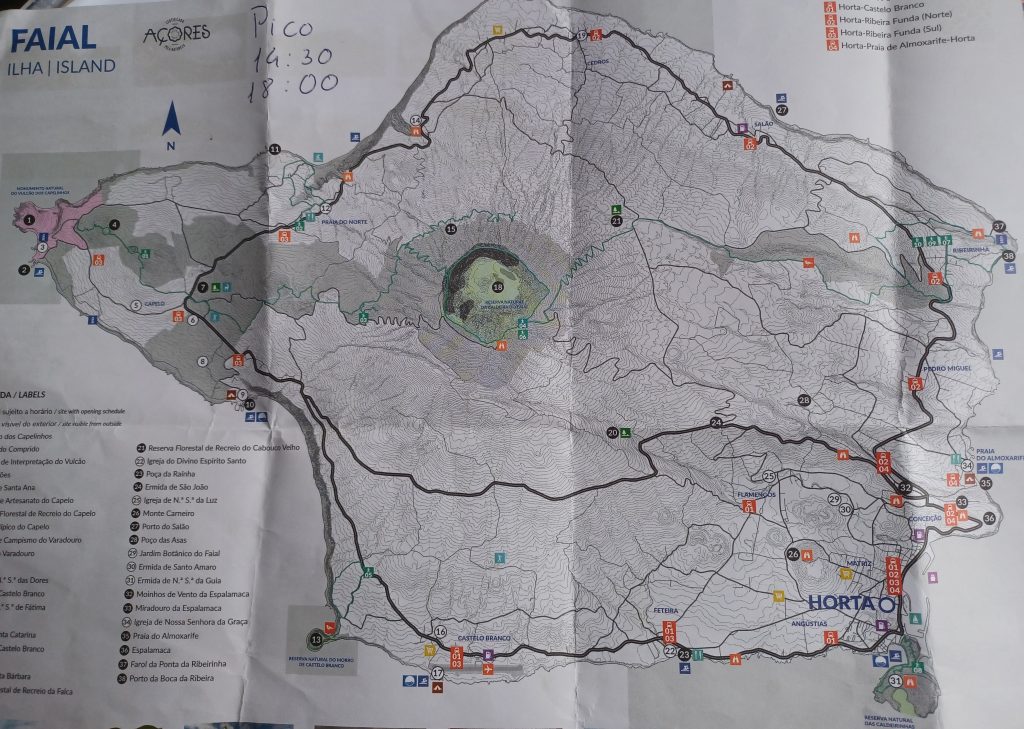
Horta
After taking leave of my friends I take the little airplane to Faial and taxi to the port of Horta. Friendly taxi driver. As before mentioned, Horta is the trans-Atlantic yachtie hub and was the place where the first trans-Atlantic seaplanes stopped. The port was built here in 1876. I mention to the taxi driver that I’d like to see the yachtie paintings in the marina. He remarks that “there are far too many of them” and space on walls is non-existent now so that, as well as on the walls, “they line the ground under your feet”.
My hotel, Hotel do Canal, is right on the waterfront. Famous place. Folks on seaplane trips from New York to Lisbon used to stay here on their overnight stops, as well as international yachtsmen in need of a good shower. Grand view of the boats from the hotel window.
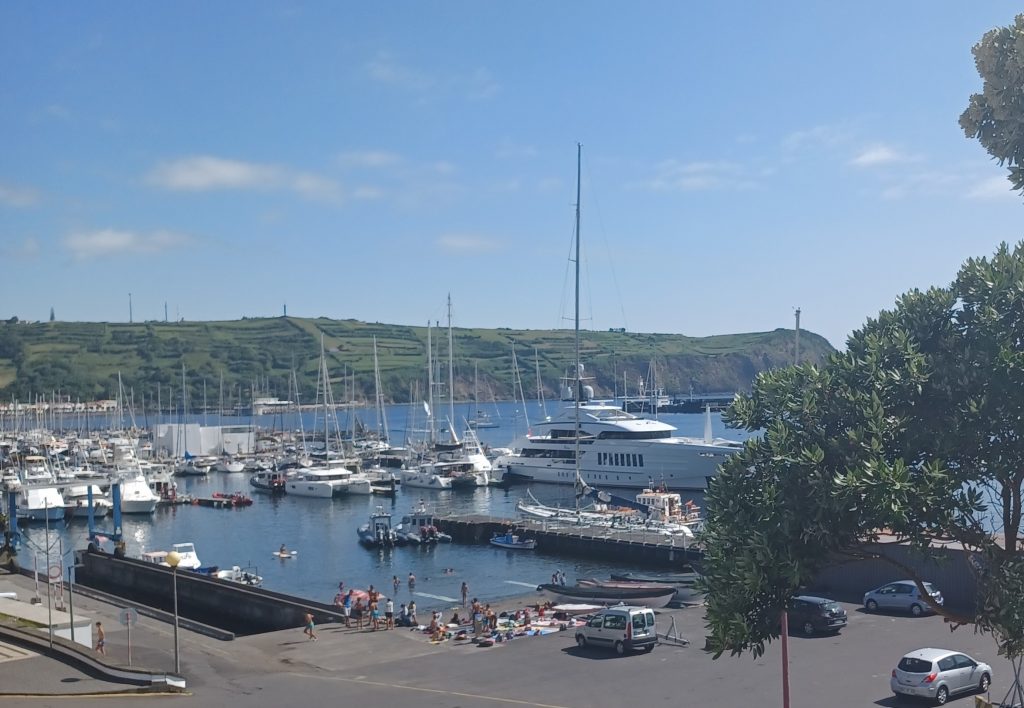
Yacht paintings, Horta
Deposit luggage in spacious room and wander off to the marina to peruse the yachtie paintings. All have the boat names, many with flags and /or nationality of the crew stated and date of visits, sometimes crew names too. The taxi driver was right. There are hundreds of them in every available space. Some are painted over old faded ones and most of those I see are dated well after 2000. I had been hoping to see some left in the 1980s when yachties I knew would have been toing and froing. Sadly, I spot none but it is like looking for the proverbial needle in a haystack.
Many yachts are moored in the harbour, some flying the Portuguese and Azores courtesy flags from their masts, the top one being the Portuguese flag, which takes precedence over the lower one, that of the Azores. The flag of the Azores has nine golden stars on it, representing the nine islands, and a golden goshawk. The goshawk, açor in Portuguese, gave the islands their name although the early explorers got it wrong and the bird they thought was a goshawk turned out to be a buzzard.
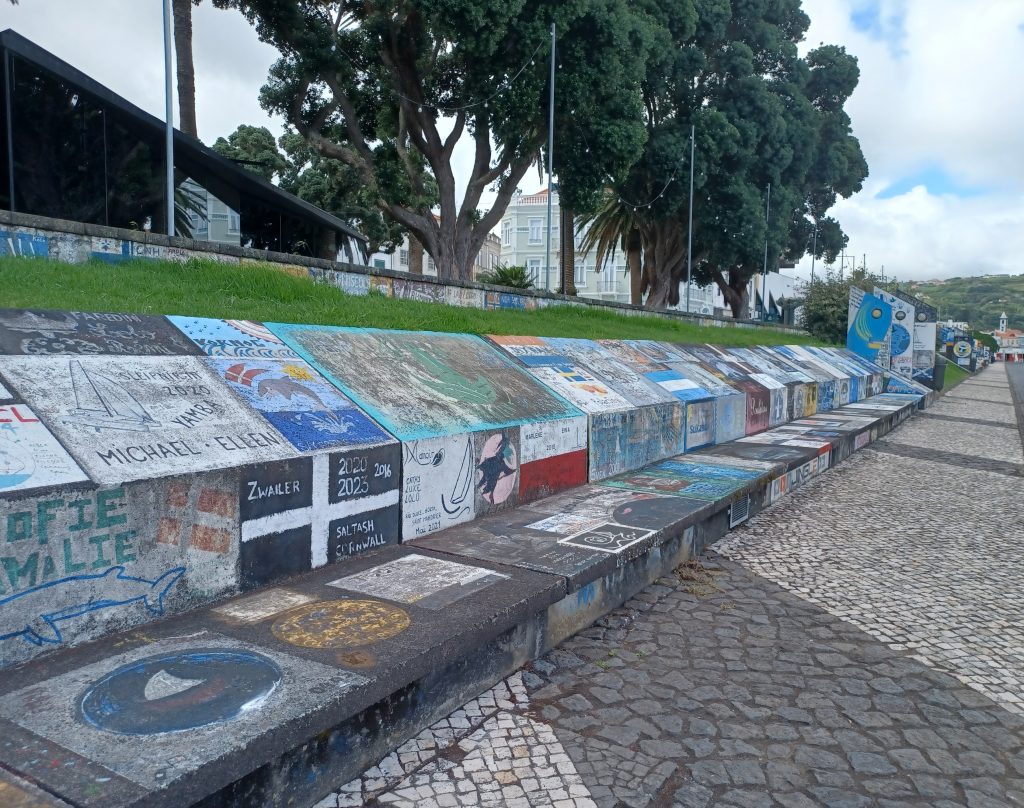
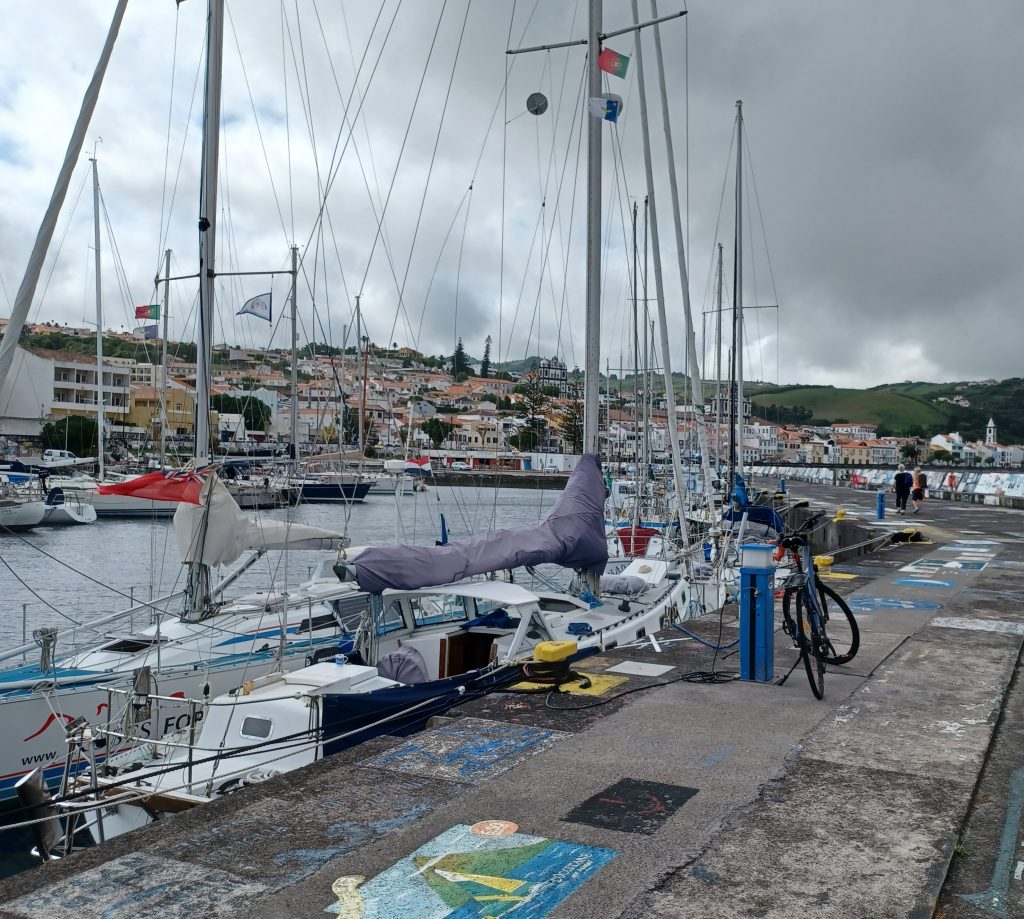
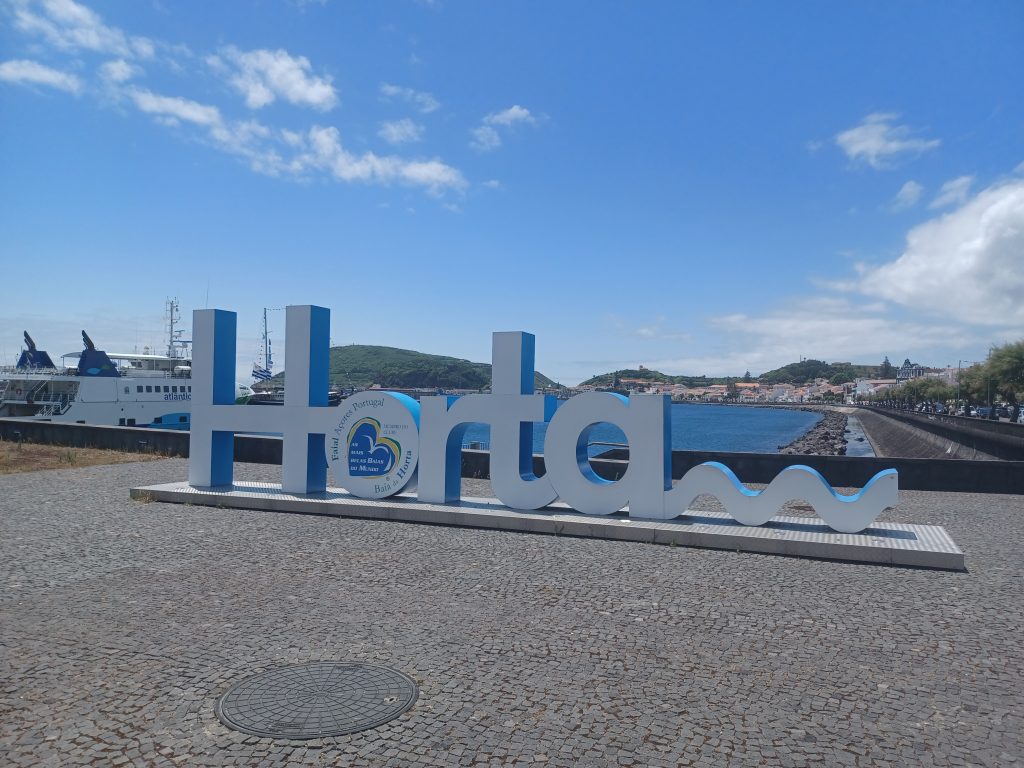
Anyway, I eventually take a longish hike to the end of the sea frontage to the quay where the Pico ferry is tied up. This ferry takes about fifteen cars as well as passengers across to Pico island. It is only about 5.5 miles from here to the port of Madalena, a thirty minute crossing. Might do that, I muse as I stroll the cobbles.
Monte da Guia
Next day the hotel organises a guide to take me round the island. Perfect day. Warm. Still. A few wispy clouds. I am driven first up Monte da Guia, named after the patron saint of fishermen. There is a steepish hiking trail up here for those energetic types.
The little harbour below the mountain is in the caldera left by a volcanic eruption. It is called Porto Pim. Between Porto Pim and Horta harbours is an observation tower on the hill. It is named after Prince Albert of Monaco, who sponsored the tower. I intend to walk up there at some point.
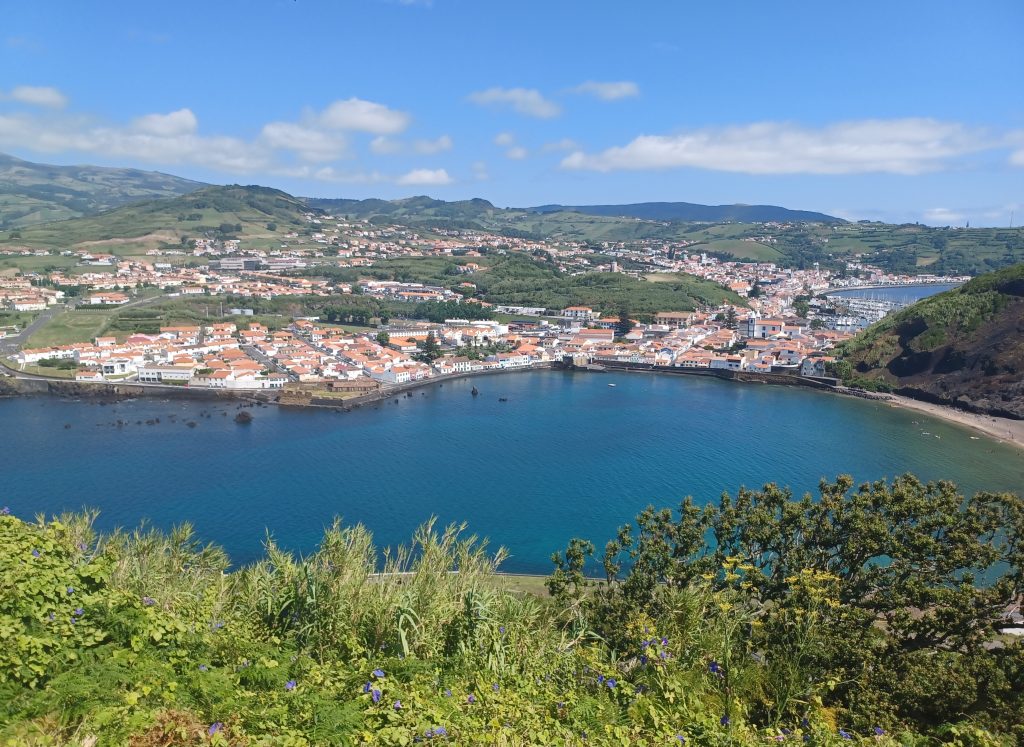
Turning about and the island of Pico with its mountain can be seen to the south-east. This is the tallest mountain in the Azores at 2,351 metres high. As I peruse the panoramas the guide tells me that there are many many shipwrecks off the coast of Faial, some near Horta harbour. One of them, a Chinese clipper, she believes, is full of “crockery”.
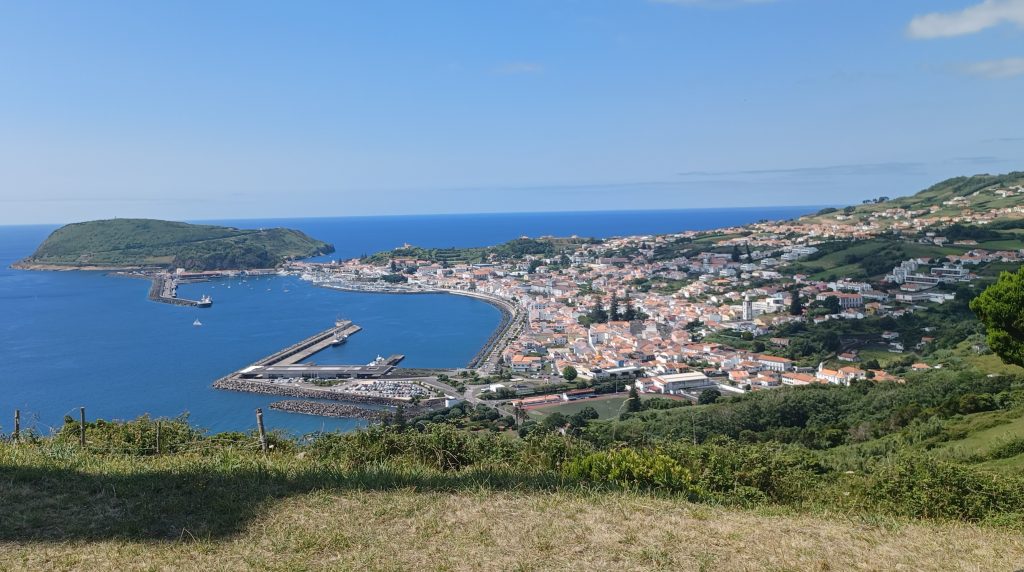
Descend the mountain into the pretty Porto Pim and then commence our drive round the island, skirting the port and ascending the hills to the north on the other side. From here one can observe the whole of Horta from a viewpoint, the Miradouro da Espalamaca.
I notice that on one of the quays near the Pico ferry point, a three masted ship is moored. Monte da Guia sits to the south. Savour the views.
Many blue hydrangeas line the roads here, as in São Miguel. My guide says they were brought in from Japan. Further along the road traversing westwards we look down from another viewpoint upon the village of Flamengos, named after the 15th century Flemish settlers. Green strips of cultivated land and trees and red rooved houses.
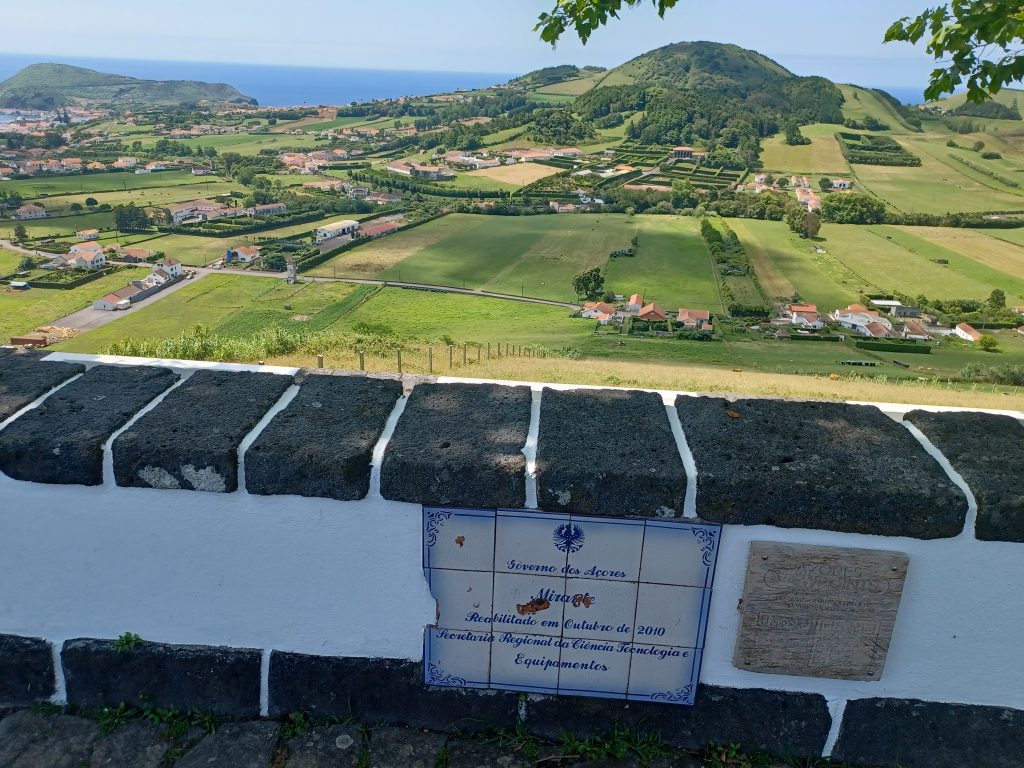
“They grew fruit and vegetables by the river there”, I am told. “The soil is very fertile because is is volcanic.” “But many of the houses were destroyed in an earthquake in 1936”. In fact, the guide tells me that many houses on Faial have been destroyed during earthquakes and, though many have been rebuilt, some buildings, including churches, are still in a state of disrepair. All looks calm and green today and cattle are grazing in the distance. Not much other animal life about except for birds. Spanish sparrows everywhere and a few terns swooping about.
Faial Caldera
At Faial’s highest point is a caldera, the Caldeira do Faial, to which we are headed. Park up and nip through a little pedestrian tunnel to the lookout point. The caldera is two kilometres in diameter and 400 metres deep. It is a nature reserve and, according to an information board, about 2/3 of the endemic flora of the Azores are to be found inside. Another signpost tells me it is 2,632 kilometres to London. OK. I wander round the rim for a while communing with nature. An eight kilometre trail round the rim is in place for hikers.
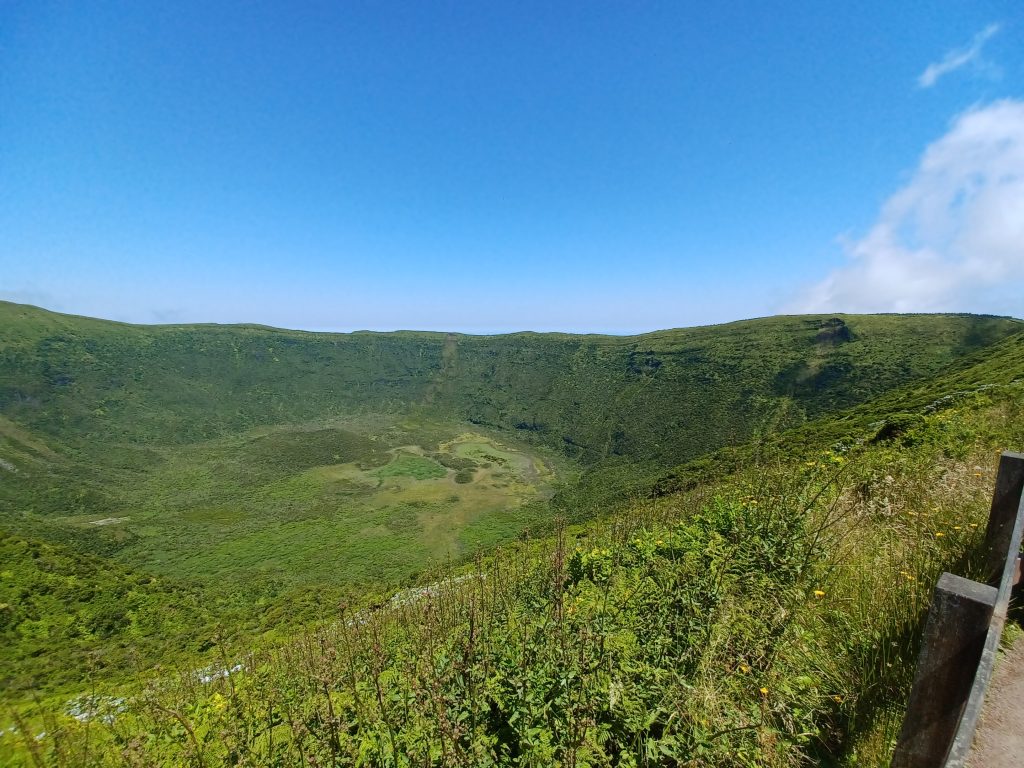
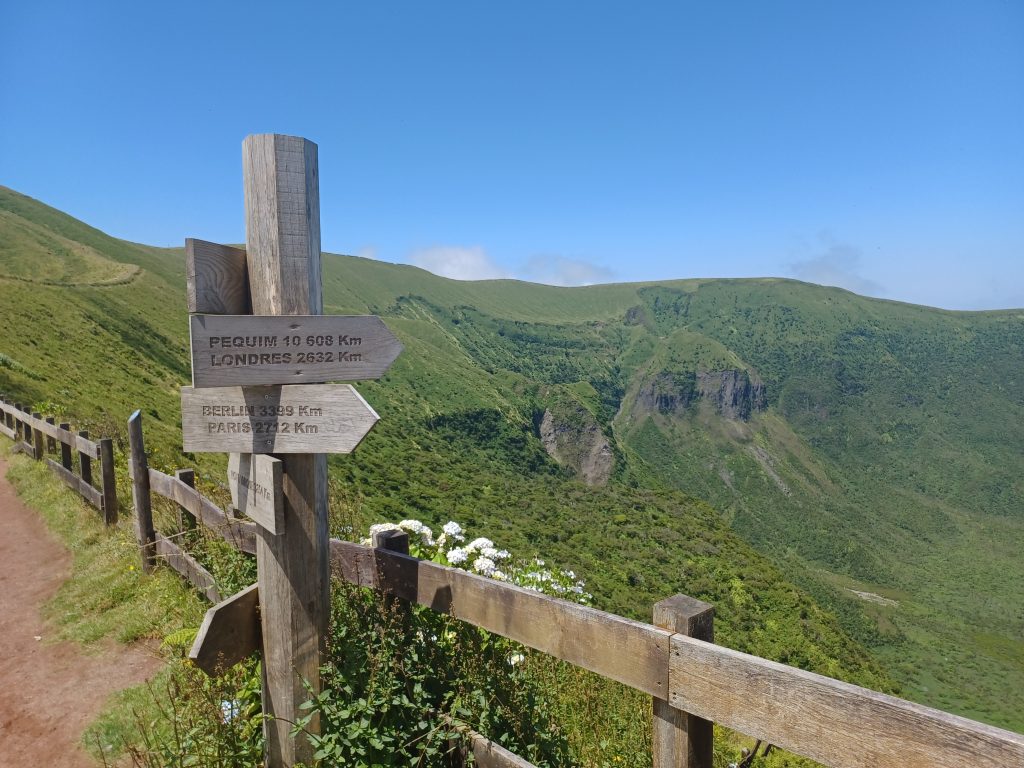
Capelinhos Volcano
On the far west point of Faial is the Capelinhos Volcano, which erupted in 1957 resulting in a two kilometres extension to the mainland. Thither we descend. The lighthouse here, inaugurated in 1903, was not destroyed but part of it was buried. As a consequence it was decommissioned. I head along a path of paving stones over the volcanic ash towards it. You can climb up the spiral steps to the top. I don’t. Too hot.
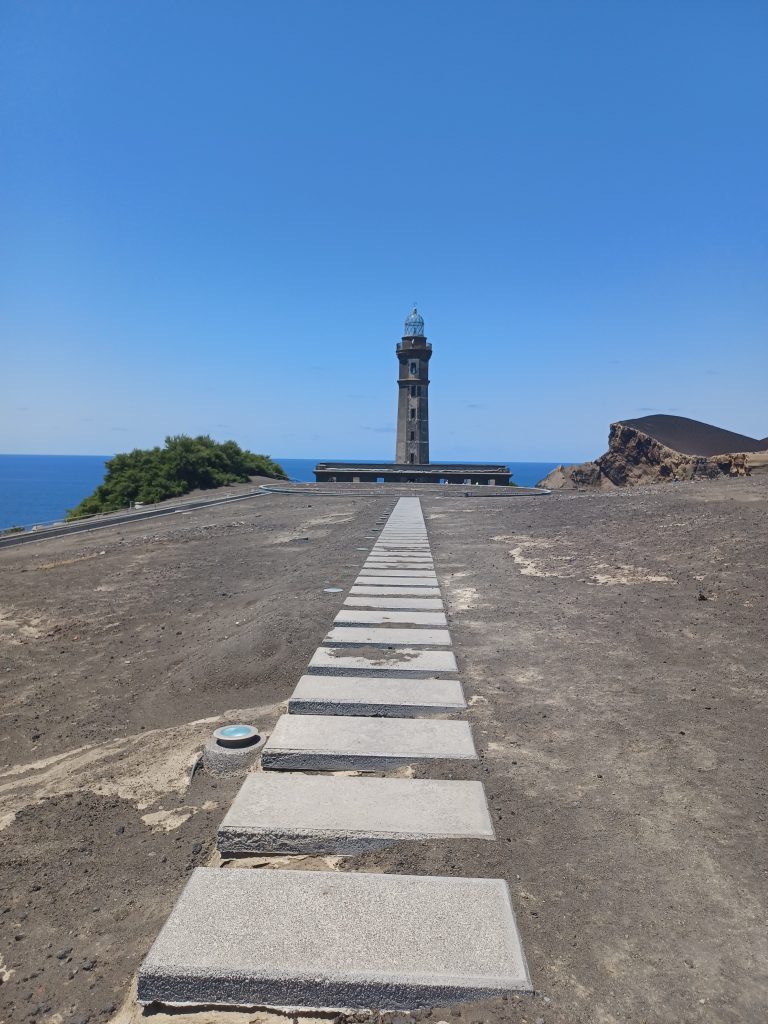
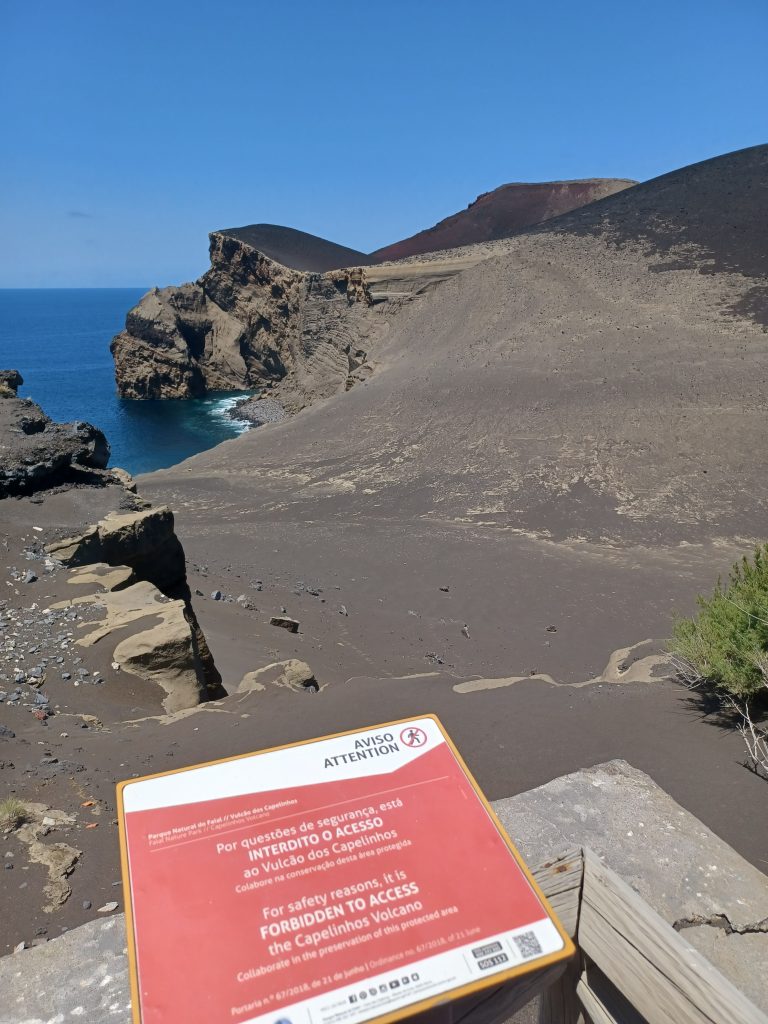
But I do go in the Interpretation Centre, which has been built underground close by. Some interesting information is displayed here about volcanoes with photographs and film clips of the eruption in 1957. A drink would be welcome but nobody is serving today from the counter of what appears to be a small bar. Hmm.
There was an important whaling station here from 1884 until 1957 where about 400 people lived in stone houses. The village got swallowed up by the volcanic eruption and abandoned. It is still possible to see the rooves of some of the whalers´ houses sticking up above the ash.
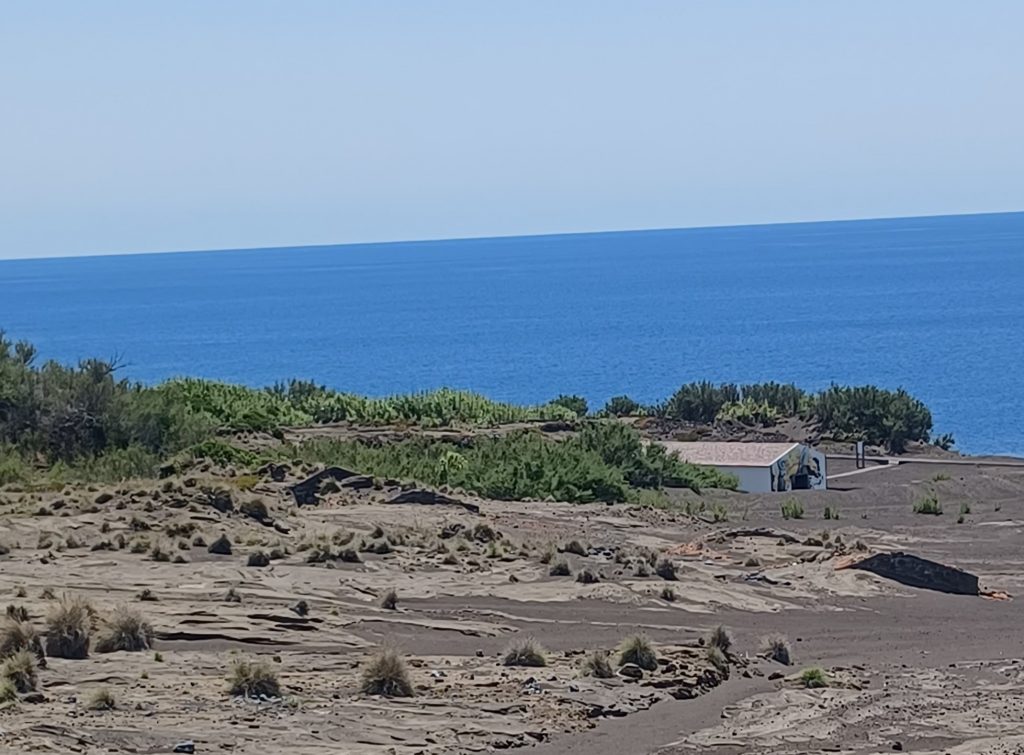
As a consequence of the eruption many people emigrated to the USA where they were, apparently, welcomed.
As before noted, whaling was once an important part of the Azores’ economy and Horta was the transhipment point for the whaling fleets. Many families made a good living from the trade in whale products, such as oil. “One whale makes 50 barrels of oil for lighting”, the guide tells me. Whaling continued until the volcanic eruption and then the general moratorium on whaling, which has affected other countries too, such as Iceland (see Iceland: Nostalgic walk around Reykjavik). Faial has since become a whale watching hub and its one-time factories repurposed into museums.
Horta
Observation tower of Prince Albert of Monaco
Further exploration of Horta is on the agenda for today. I set off to walk behind the hotel and climb a winding unmade road on the slopes of Monte das Moças, at the top of which is perched the observation tower funded by Prince Albert I of Monaco as a meteorological station. This is the building that I observed from Monte da Guia. Apparently Prince Albert was keen to build a network of meteorological observatories in the Azores and he, together with King Carlos I of Portugal, both interested in scientific observations, managed to achieve their aim. This one was named after the Prince in 1923.
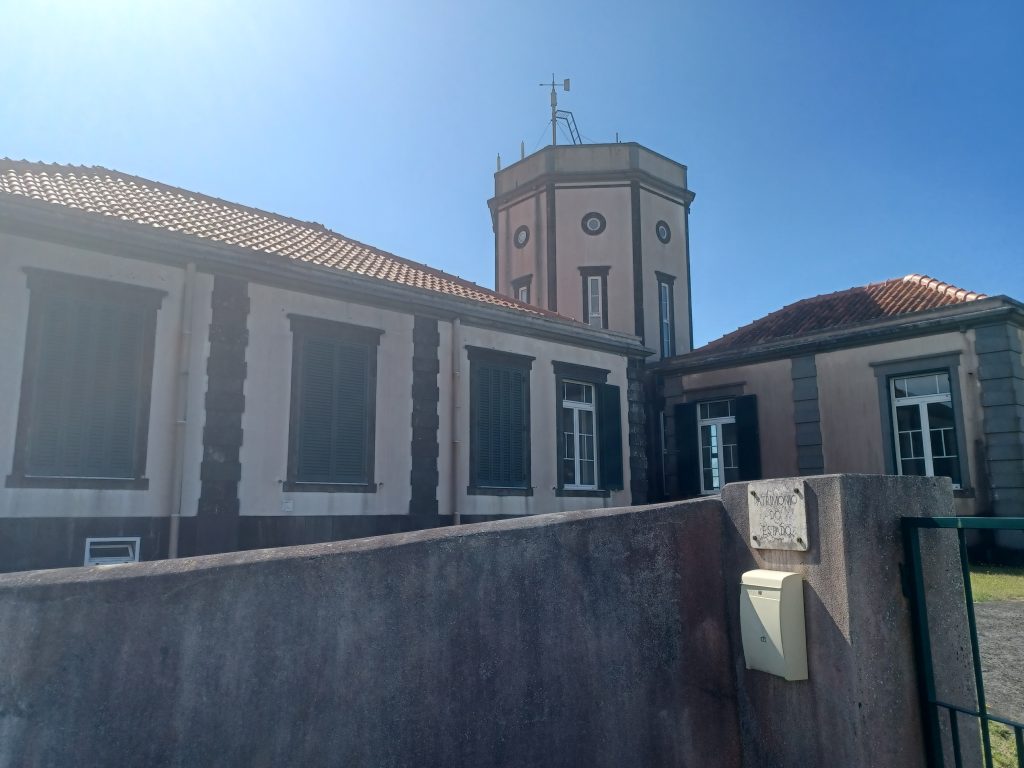
After the 1998 earthquake the tower had to be restored and was, again, funded by Monaco. Today, as well as conducting meteorological observations, the tower contains seismographic recording equipment and monitors volcanic activity. Another delightful view from here.
I continue my promenade along the path high behind Horta parallel to the waterfront then descend into town. I cross squares and pass glorious buildings with glimpses into back gardens of fig trees and flowers. And a disused church with fencing across its doors, the church of São Francisco, apparently damaged by fire decades ago. I am seeking out the Museum of Horta, which is housed in an old 18th century Jesuit College. It is attached to the magnificent Church of Matriz do Santissimo Salvador.
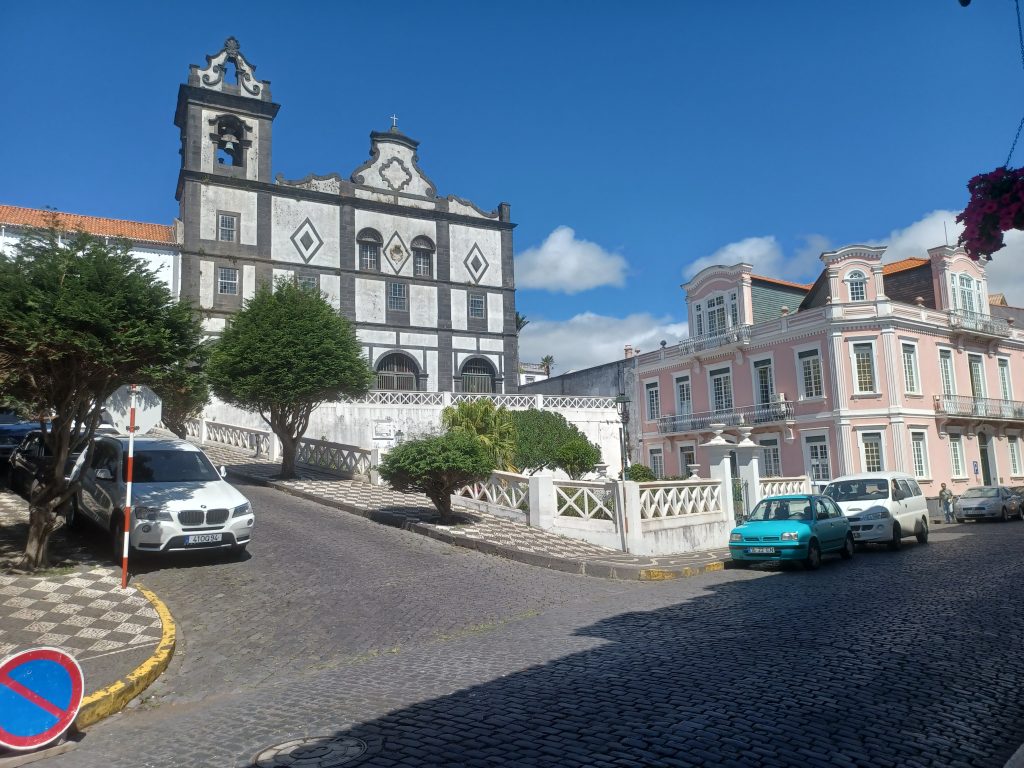
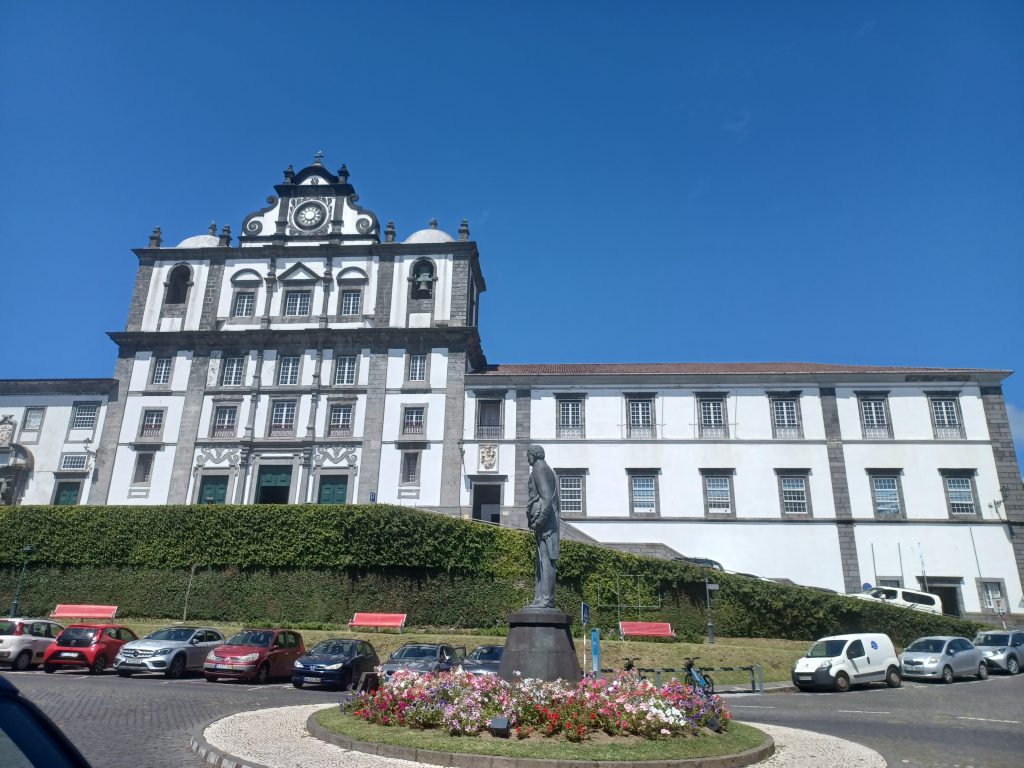
Museum of Horta
Within the museum, an absorbing collection of objects and information is assembled.
Early submarine cables
A map which depicts the first British submarine telegraph cables is on view. I learn that the first cable to reach Horta was laid from Carcavelos just south of Lisbon in 1893 and the first from Porthcurno in Cornwall to Horta was laid in 1906. In those early days the international cable network was dominated by Britain, who had a concession from the Portuguese government to lay the cables. French, American and German cable companies soon got in on the act and also established telegraph companies in Horta. Some of their buildings still exist, for example Trinity House, built in 1902, which was shared by three telegraph companies, that of Britain, USA and Germany. By 1928 Horta, in its strategic location in the mid Atlantic, was the central hub for fifteen submarine telegraph cables connecting the USA and Canada to Europe. It all came to an end in the 1960s when new technologies took over.
Early flying boats
A model painted yellow of a flying boat catches my eye. The model is of the Navy-Curtiss flying boat, one of which, the NC-4, arrived here about 100 years ago. This seaplane was the only one of four in the squadron to complete the crossing from the USA at that time. There is a photograph of it tied up in Horta’s bay. Quite a bit of info here about those first seaplanes.
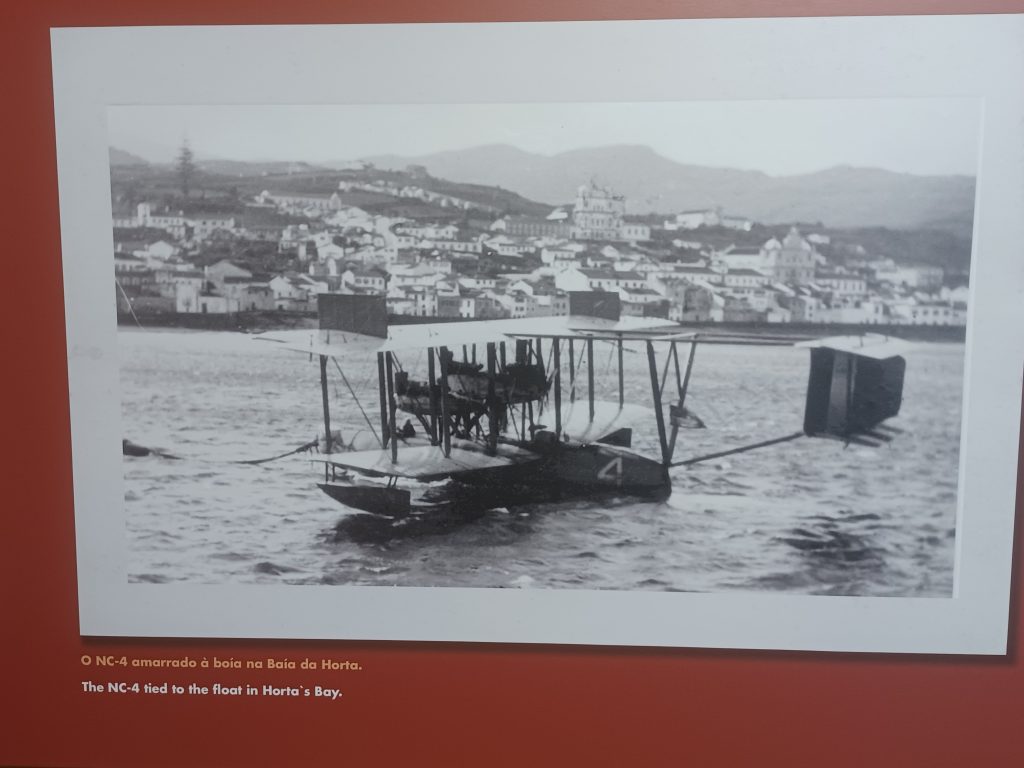
Fig tree pith models
Further on is a display of models made out of fig tree pith. Novel. The pith comes from the interior of mature branches of the fig tree, I read. It is dried for an hour in the sun and cut into thin slices. Arabic gum is used to stick the pieces together. Intricate models of ships, including Cutty Sark, and flora and fauna are displayed. This craftwork has become one of Horta’s traditions.
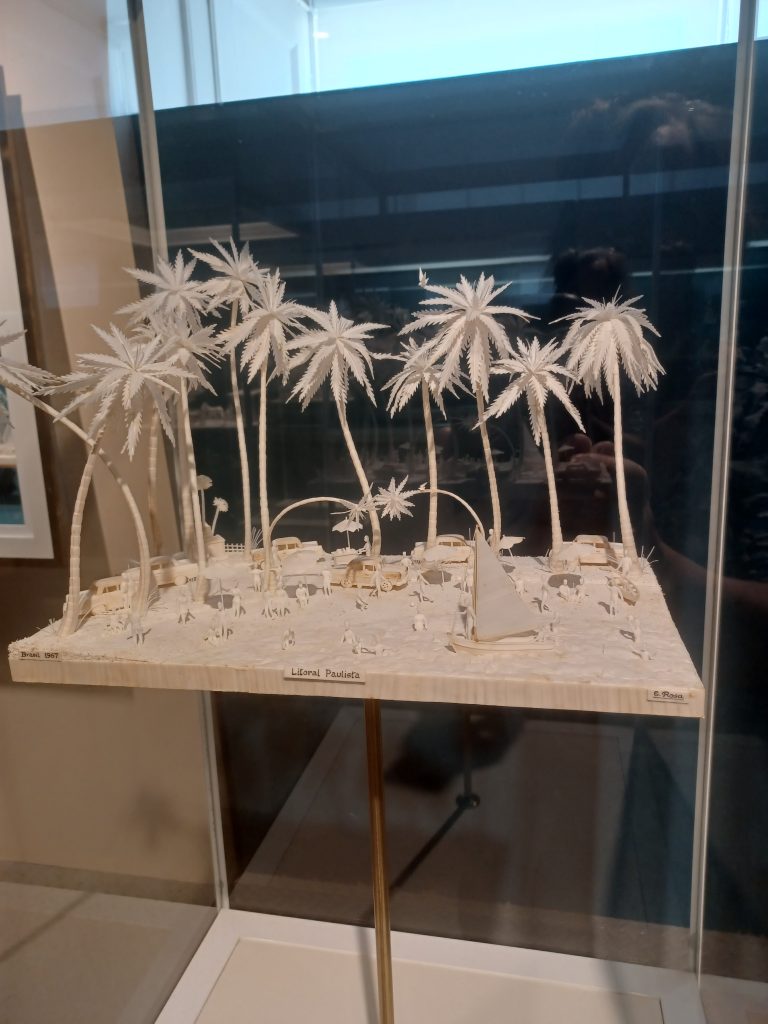
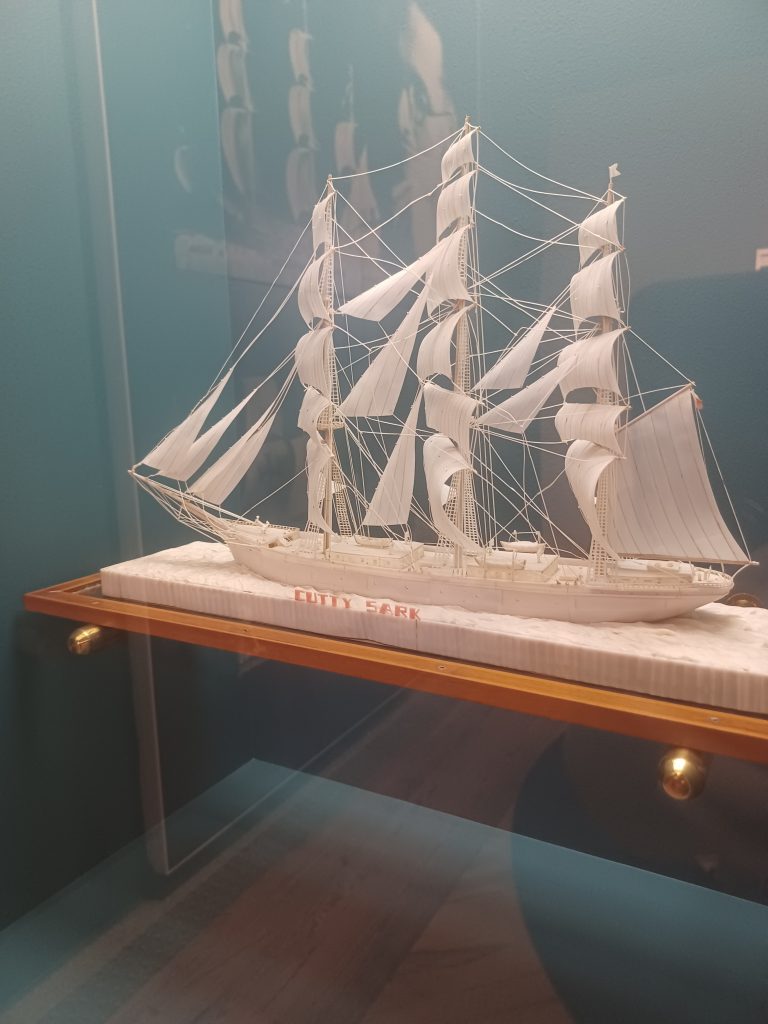
Fort of Santa Cruz
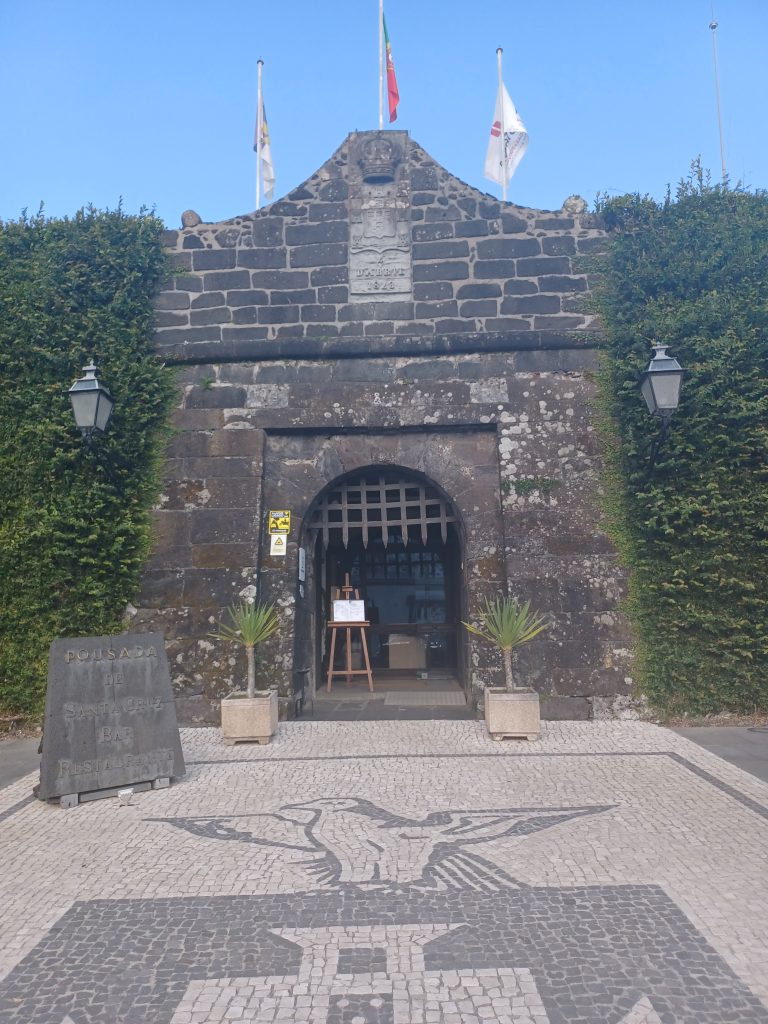
I wander hotel-wards past the Pousada of Santa Cruz, which began life as a fort, the Fort of Santa Cruz, built in the 16th century to defend the port against pirates. Hence all those shipwrecks off Horta that my guide was telling me about. The Spanish occupied the fort in 1583 and the British invaded in 1597 as part of their campaign to occupy these then Spanish possessions in the Azores. Led by the Earl of Essex with Sir Walter Raleigh as his Rear-Admiral, they attacked the port and set Horta on fire. But the attempt to seize the islands ended in failure. The fort was saved from demolition in the 1930s and is now a pousada (hotel).
Peter’s Café Sport
Close to the hotel is Peter’s Café Sport, a famous watering hole, which has been here for three generations. It became a meeting point for yachtsmen, a place where said yachtsmen could find help, and send and receive post. Walls and ceiling are covered with yachtie flags and insignia. Bit busy, animated conversations going on and a bit of a queue at the bar. But I manage to procure a glass of Portuguese red, sit down at a wooden table and muse awhile. This is where we would have come, my husband and I, years ago on our Icelandic registered yacht, had we returned home across the Atlantic. But we didn’t.
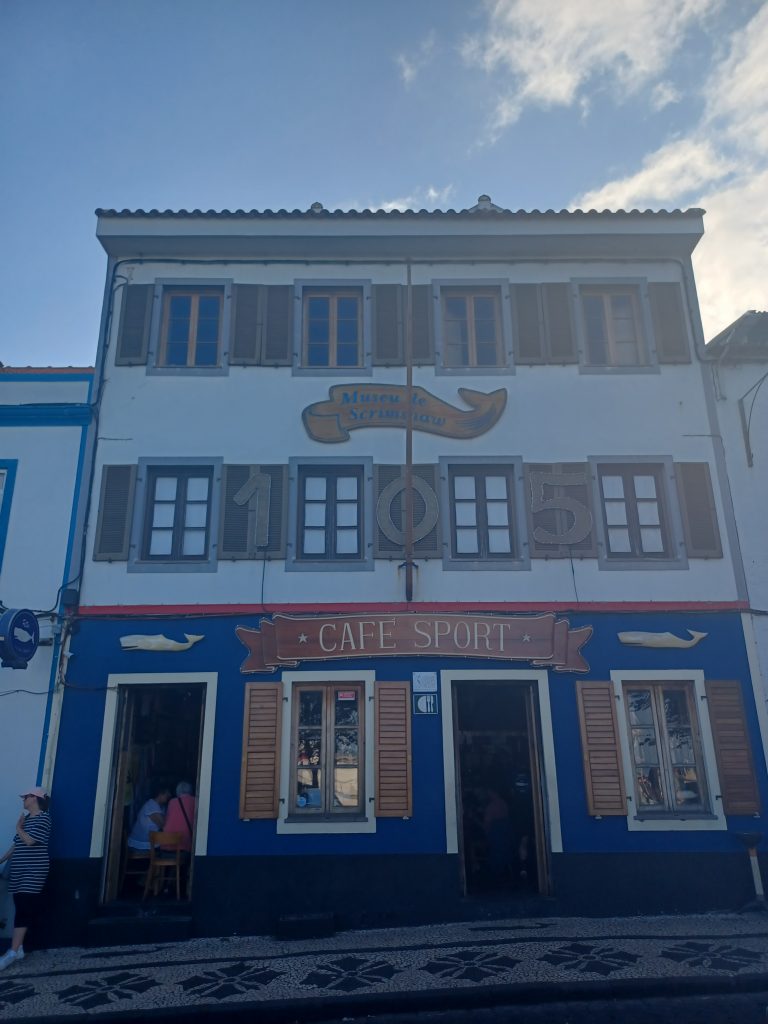
Eclectic mix of clientele here. Yachties, tourists, locals. I meet an English Professor of Philosophy. Have deep and interesting conversation. You never know who are you going to meet. One of the joys of travelling alone. Turns out he is retiring to Faial and is house hunting. Not a bad idea.
Porto Pim
Last day. Venture from the Hotel do Canal to Porto Pim, the little sheltered harbour within a caldera. This is the little port I gazed down upon from Monte da Guia and it is only a short amble along a narrow street to get here. Porto Pim was the place where the first settlers of the island arrived in the 15th century. A harbour was built in the 1600s to allow ships during the age of exploration to dock here and the fort of São Sebastião was built to protect it against pirates. The fort is connected by a defensive wall to a large sea gate atop which once perched ten cannon.
A popular sandy beach, the Praia do Porto Pim, runs along the base of Monte da Guia. Hikers descend onto it after scrambling up and down the mountain. Immediately to the right of the beach was once a whale factory, the Porto Pim Whale Factory which, in its thirty years of operation, produced 44,000 barrels of oil. It closed in 1974 and is now an interpretation centre. And beyond that is Dabney’s House, painted yellow. The Dabneys were an American family of three generations, who imported goods from America and exported wine as well as whale products. The house is now a museum.
Porto Pim is a picturesque place. Brimming with history and colourful houses and old defences along cobbled roads. And behind it all in the distance looms Mount Pico. A layer of cloud floats half way up it today. I settle down onto a chair in a café and take it all in.
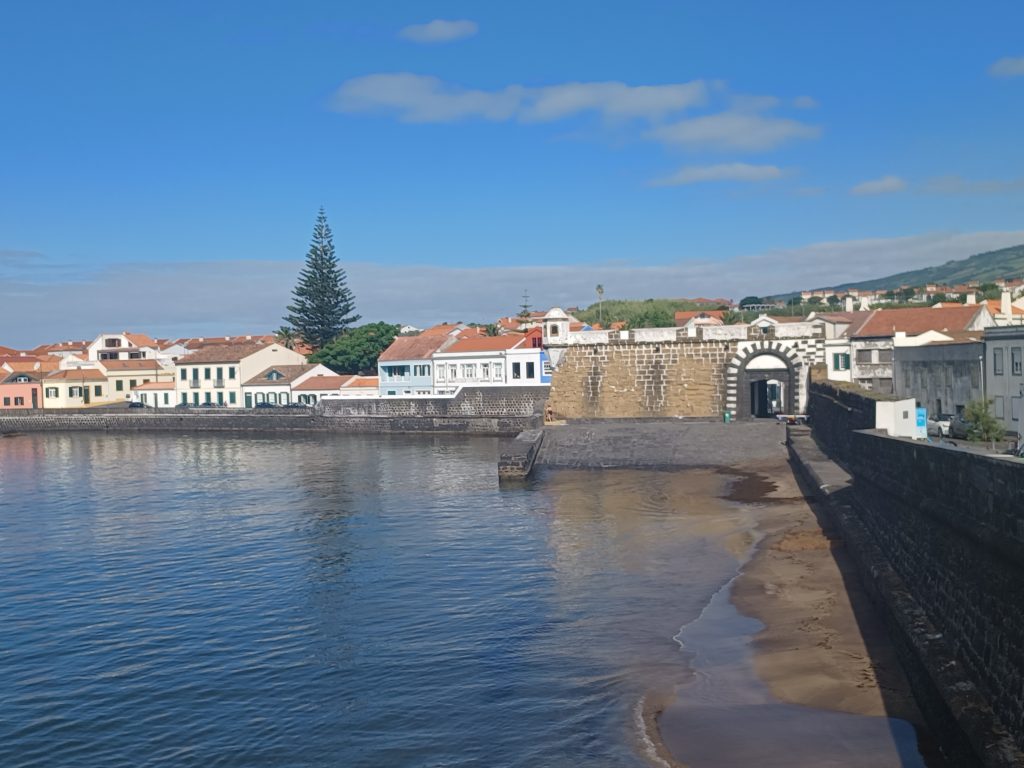
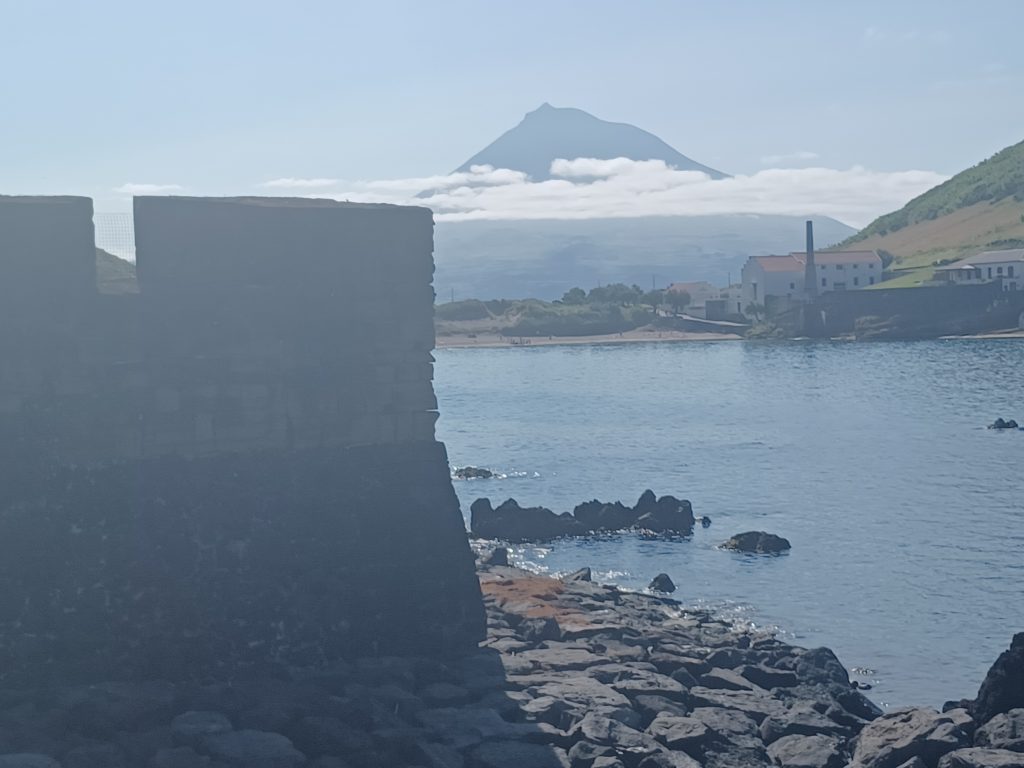
My adventure in the Azores is over for the time being. Fabulous islands. Plan to return to view some of the other nine in the nearish future.

Leave a Reply